Okisato Nagata / NOMURA Co., Ltd.Comprehensive Space Production Company
Recommend Tour09
Okisato Nagata / NOMURA Co., Ltd.Comprehensive Space Production Company
Recommend Tour09
A journey to explore new possibilities of “space × materials"
A trip to Echizen City for people of various backgrounds to experience the city's climate.This time around in Echizen City, we will be joined by Nomura Co., Ltd. who are involved in a wide range of activities from space planning, design, and exhibition to promotion.Guided by planner Mr. Okisato Nagata, who is well versed in craftsmanship in various regions of Japan, we embarked on a trip to Fukui's craftsmanship, with a focus on Echizen City.
.jpg)
Mr. Okisato Nagata
Representative of TIMELESS, Planning Director.His activities focus on plan design and design direction to solve problems in a wide range of fields from the field of art and traditional crafts to new business development for companies.

.jpg)
NOMURA Co.,Ltd.
A comprehensive space production company that handles everything from interior design and exhibition planning to design, production, construction, and operation management.The company is working to create a wide variety of visitor-attracting spaces by creators and manufacturing specialists.
Echizen City is home to a variety of craftsmanship.Recently, it has expanded beyond crafts to be used as interior and building materials for homes and stores, and its use is increasingly seen in hotels and other commercial spaces.In this time, space specialists will visit Fukui's manufacturing sites, mainly in Echizen City, to explore the possibilities.
We came to the Imadate district of Echizen City. Echizen City is the birthplace of Echizen Washi, a traditional craft of Echizen City.
Washi is so strong and durable that it is said to withstand preservation for more than 1,000 years.Its unique texture and feel have attracted attention from around the world.
The first stop was the Iwano Heizaburo Paper Mill.
"This is the largest workshop in Japan for handmade washi paper,and one of the few paper mills that can make the washi used by artists and large sheets of washi made by a team of four or six people.,” says Nagata, the guide.First, we toured the factory to see how Echizen Washi is made.
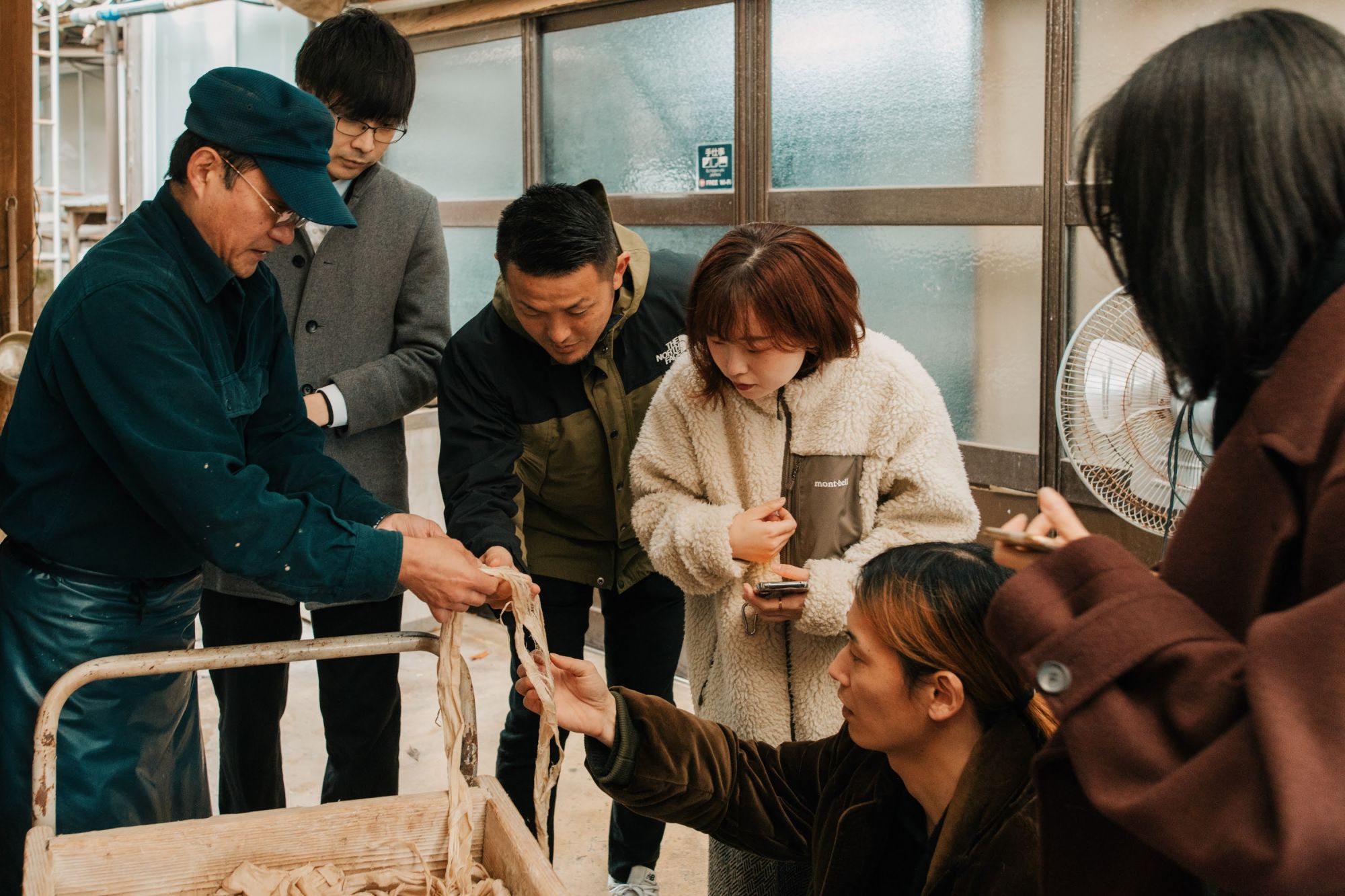
The main raw materials for washi are plants such as kozo (paper mulberry), gampi, and mitsumata.Each of these papers has long and strong fibers, but each has its own superior characteristics, and the raw materials used differ depending on the type of paper.
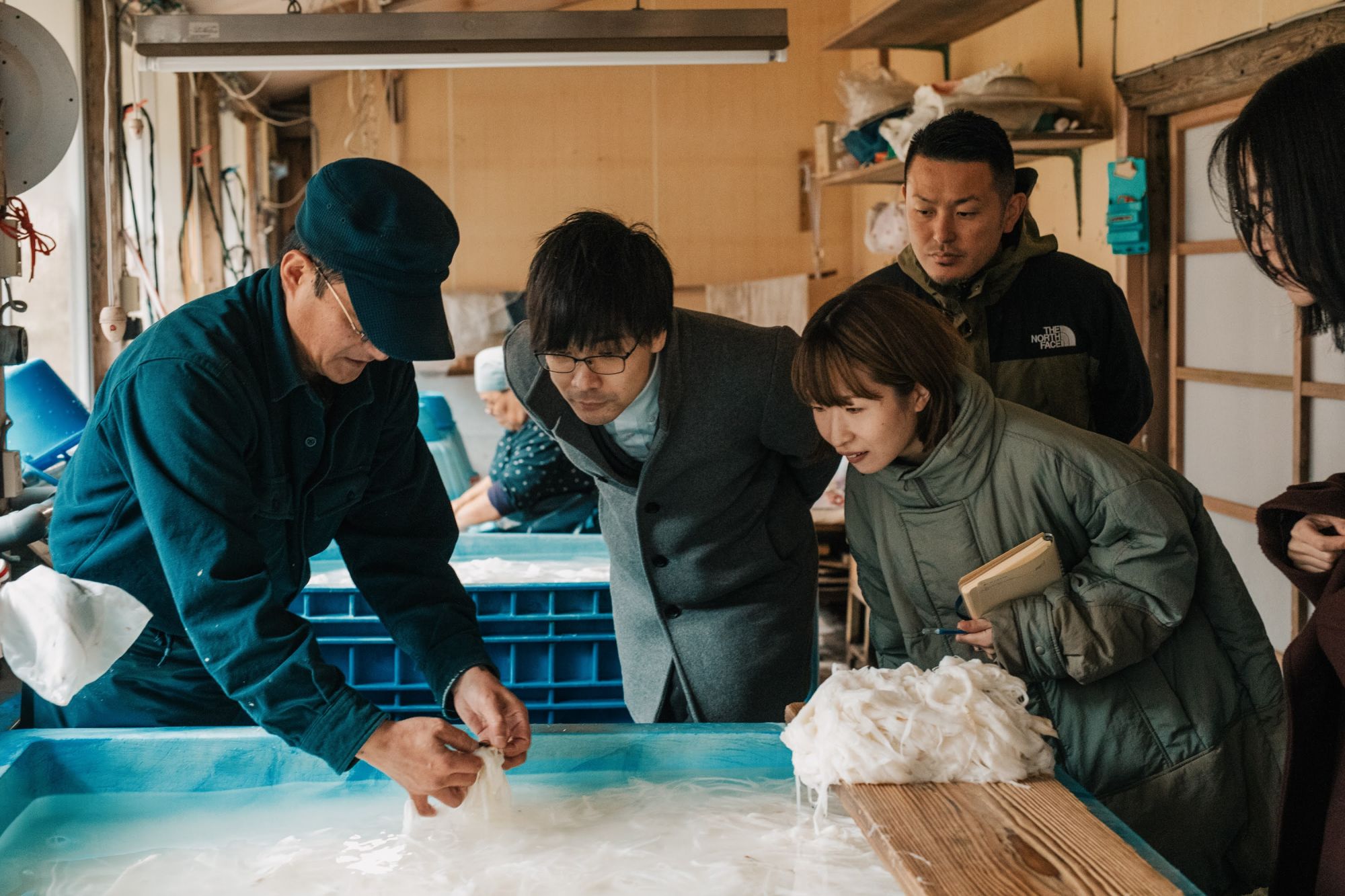
The cuttings are steamed in a kettle, peeled, and the black surface is scraped off to make the white skin.The skin is beautifully white in this state, but from here, the skin is further exposed to water to remove fine dust.
One by one, the white bark is manually loosened to find and remove dust, which is then found and removed again...is a repetitive process.Through a mind-boggling and meticulous process, it becomes the raw material for paper.

After dusting, the raw materials for washi are crushed into fine fibers and mixed with “neri,” a thick vegetable mucilage, and finally the paper-making process begins.
The craftsmen work in perfect harmony, repeatedly pumping raw materials into the girders and moving them lengthwise and crosswise to make large sheets of washi one after the other.
After this process, the water is pressed to squeeze out the moisture and then dried.One by one, they are attached to ginkgo boards and put through room drying (murokanso) in a warm room.
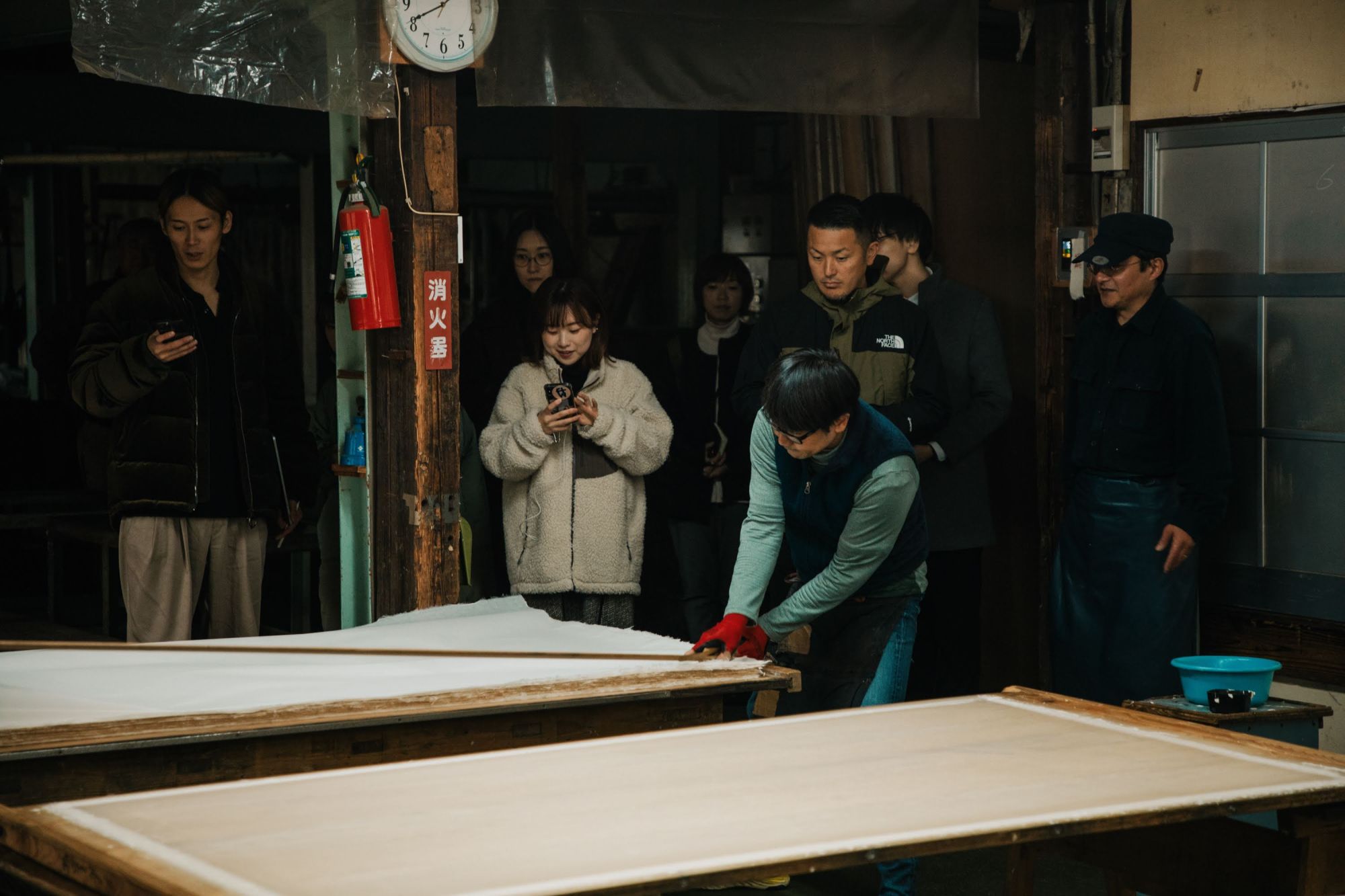
Ginkgo is used because it is less curly when dried in the sun.The wood itself also has fewer knots and a smoother finish, which is why it is used in many Echizen washi factories.It is also important to dry slowly over time, as higher temperatures may cause the product to turn up before it dries properly.
It takes two people to peel the dried washi off the board, and after inspection, it is finally completed.
After observing the washi-making process, visit the main building, which is also designated as a cultural asset.
At the 180-year-old Iwano Heizaburo Paper Mills, the techniques handed down from one generation to the next, such as the ancient Echizen washi papermaking pattern, have been handed down from the first generation of Iwano Heizaburo.
For example, this “Uchigumo” is one such example.It is made of indigo and purple fibers designed to resemble waves, like clouds fluttering in the sky and earth of the paper, using a classic and traditional technique that has been practiced since the Heian period (794–1185).
NOMURA Co.,Ltd. staff members listen to the craftsman's talk while holding washi made with various techniques other than Uchigumo.I felt the depth of Echizen washi's versatility in expression.
Next we came to Igarashi Paper, which was established in 1919.
This long-established washi factory produces a wide range of washi, from large-format paper to small items, with a focus on fusuma sliding doors and wallpaper. Its handmade large-format creative washi are used in a variety of spaces, including hotels, restaurants, public facilities, and cultural institutions.
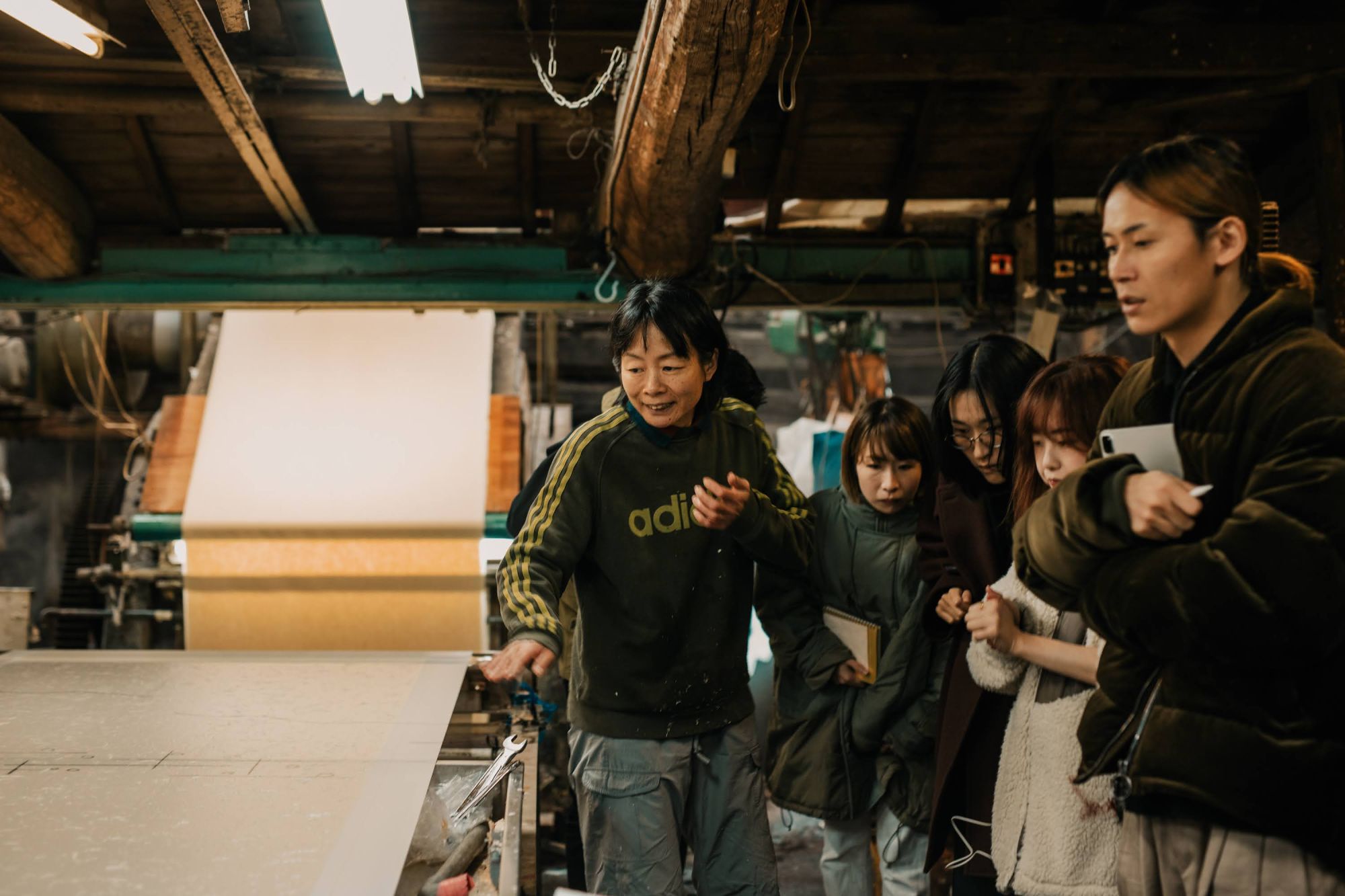
Masami Igarashi (left photo), the fourth generation of the company, will lead us around the factory.Igarashi Paper mills not only handmake but also machine-make paper.The sight of the large, steamy machine in action is very powerful.
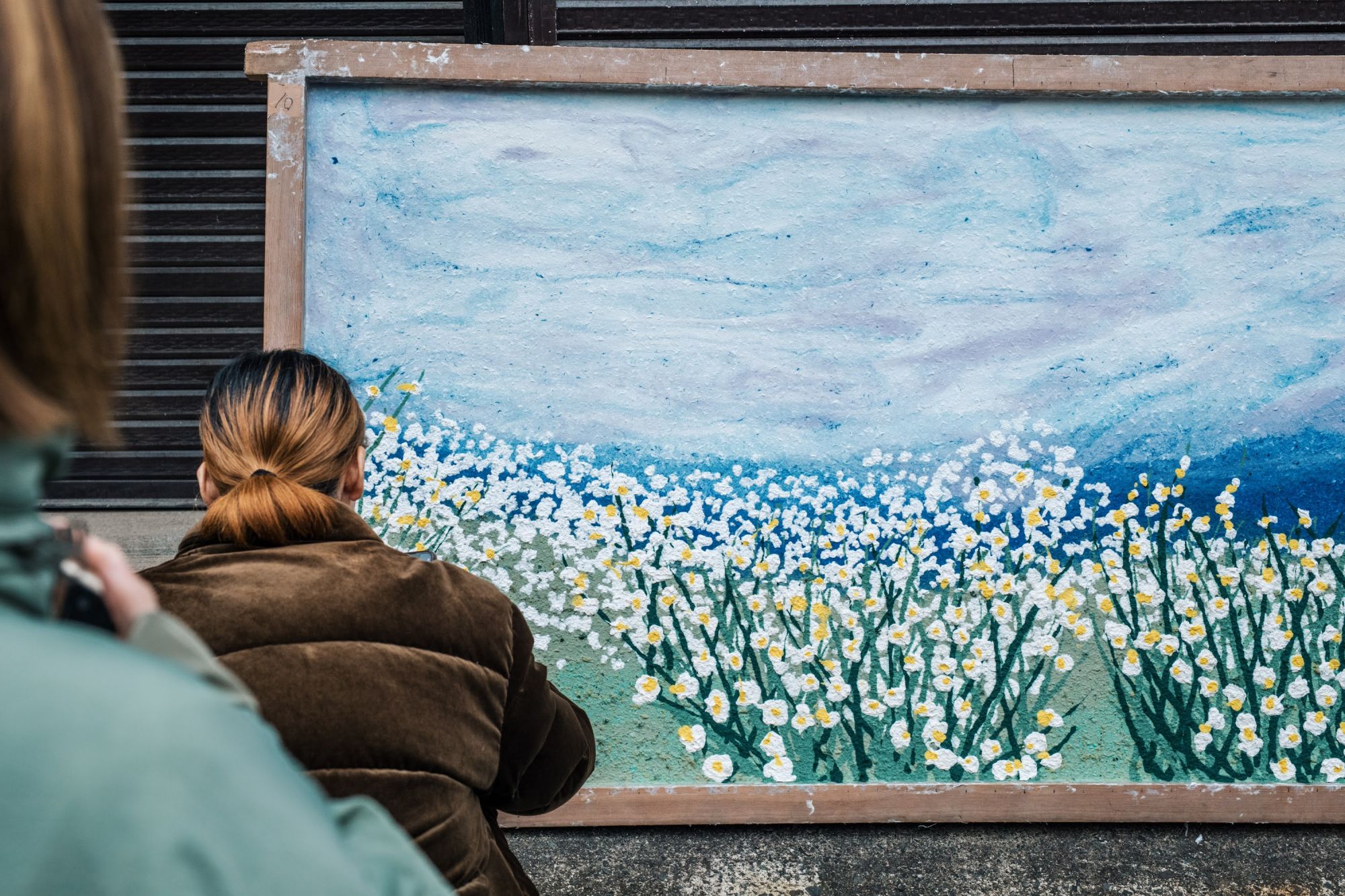
Igarashi Paper Mills often handles custom paper for famous artists and is highly regarded for its technical capabilities.The works, which look like oil paintings, are all made from washi.Although it is Japanese paper, it is also capable of three-dimensional expression.
Igarashi Paper Mills has been working on a project called “Food Paper,” a Japanese paper made from food, for several years.Washi is Japanese paper made from food such as vegetables and fruits, and is used to make paper stationery and other paper products.
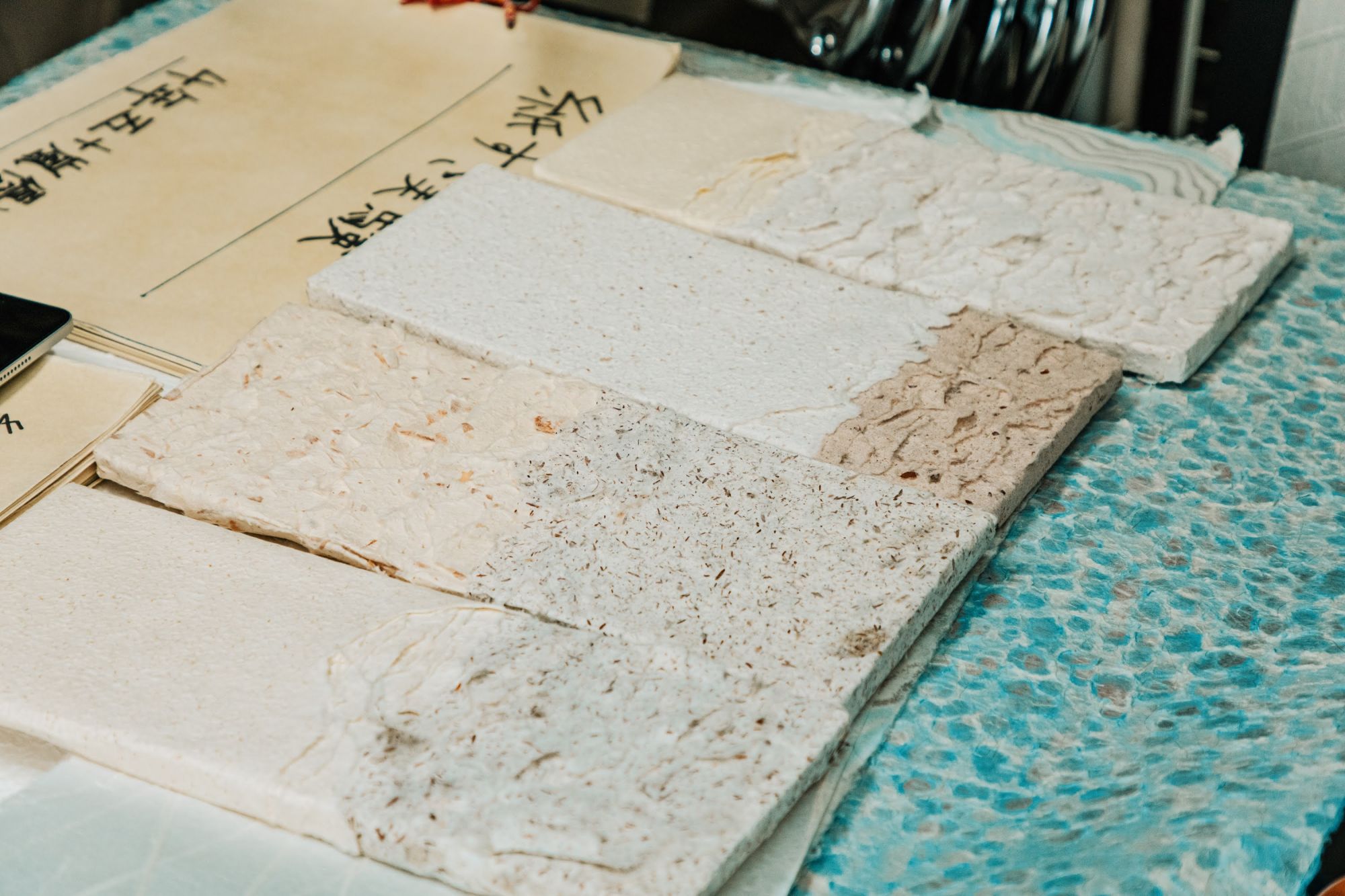
Kozo, mitsumata, and ganpi, the raw materials for washi, used to grow wild in the mountains and fields, but their harvests are decreasing every year.Some workshops even grow their own kozo (paper mulberry) to secure the raw materials.
In an effort to do something about the shortage of raw materials, Ms. Igarashi's second son spent five years from the time he was in the fourth grade of elementary school making paper from banana peels, peanut skins after eating them, edamame beans, and other familiar foods, and compiling the results of his experiments in a file.
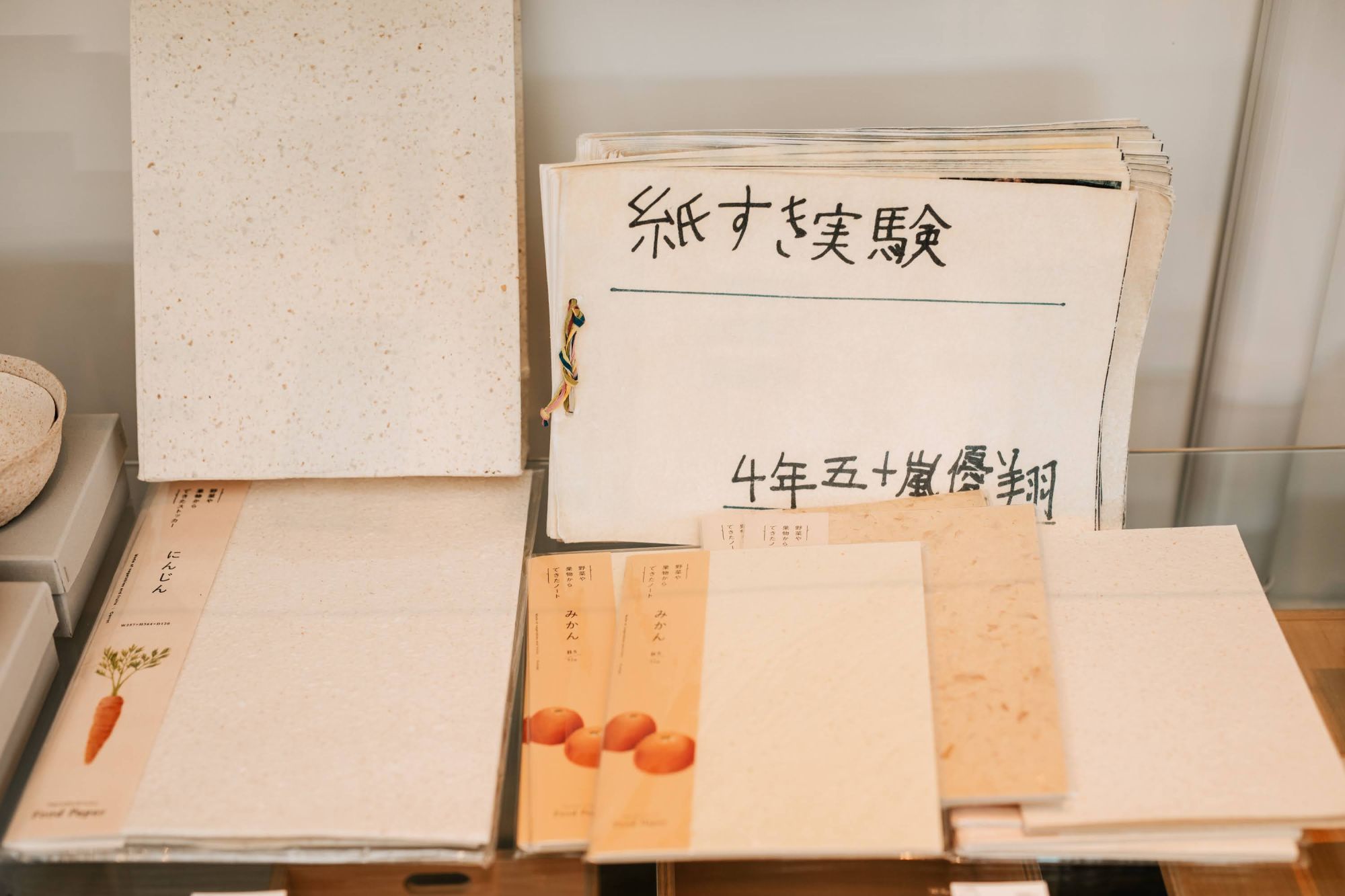
Inspired by this summer science project , “Food Paper” was created by combining traditional handmade washi techniques with a new material :food.
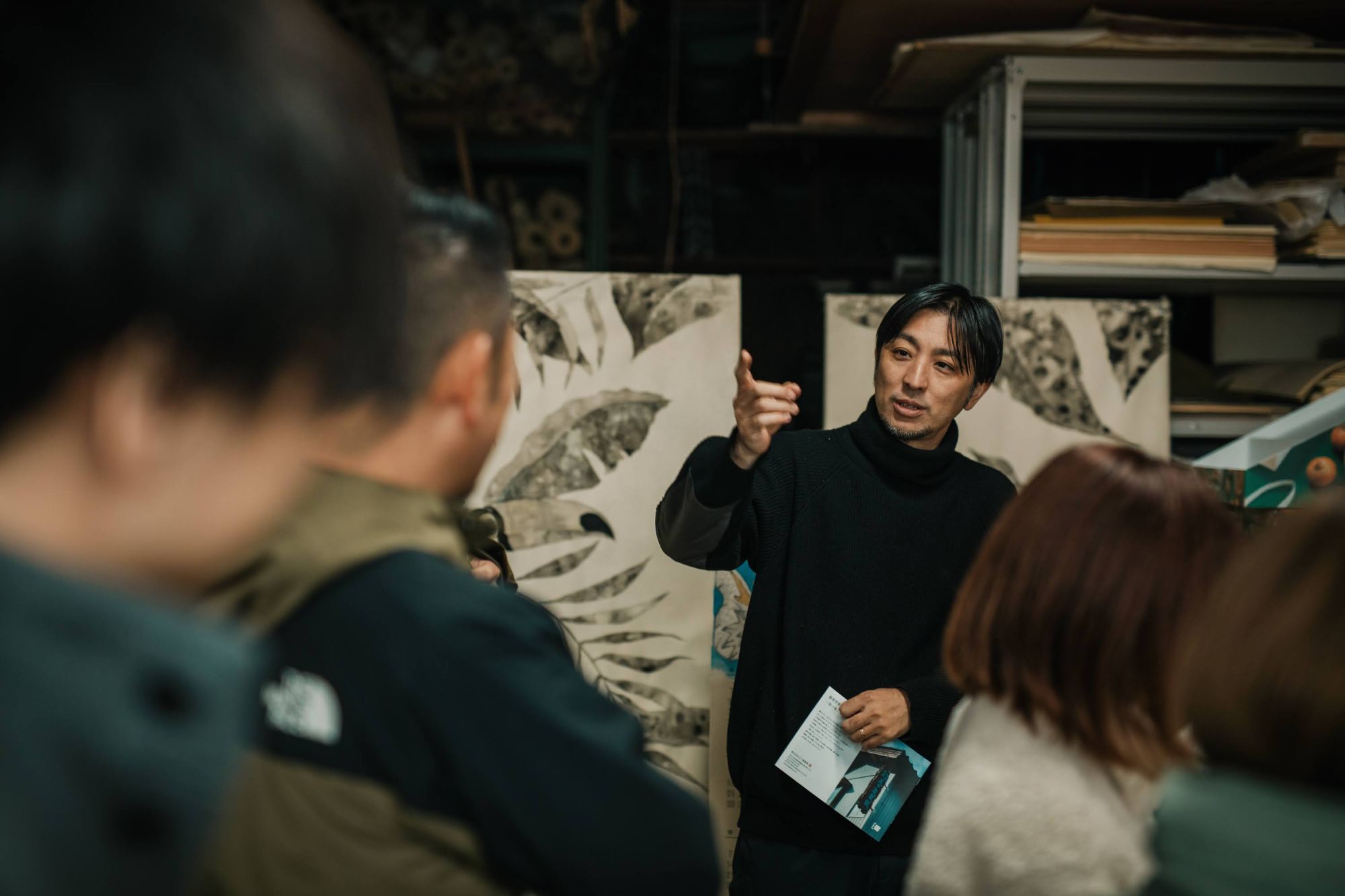
"It's interesting to see how the colors and textures change when you combine different foods, since discarded vegetables and fruits can be used in their entirety, this could be a promising initiative to reduce food loss,” says Mr.Nagata.
“We have many projects that require sustainable design, so a product like FoodPaper, with its local story, can be used in a variety of places.” NOMURA Co.,Ltd. spoke also enthusiastically about the possibilities of Food Paper.
The next stop is “Osada Paper Mills”.Osada Paper Mills, founded in 1909, specializes in the production of handmade fusuma paper, which is rare in Japan.From plain sliding door paper, the company has improved its designs over time, creating a variety of patterns despite the handmade paper.
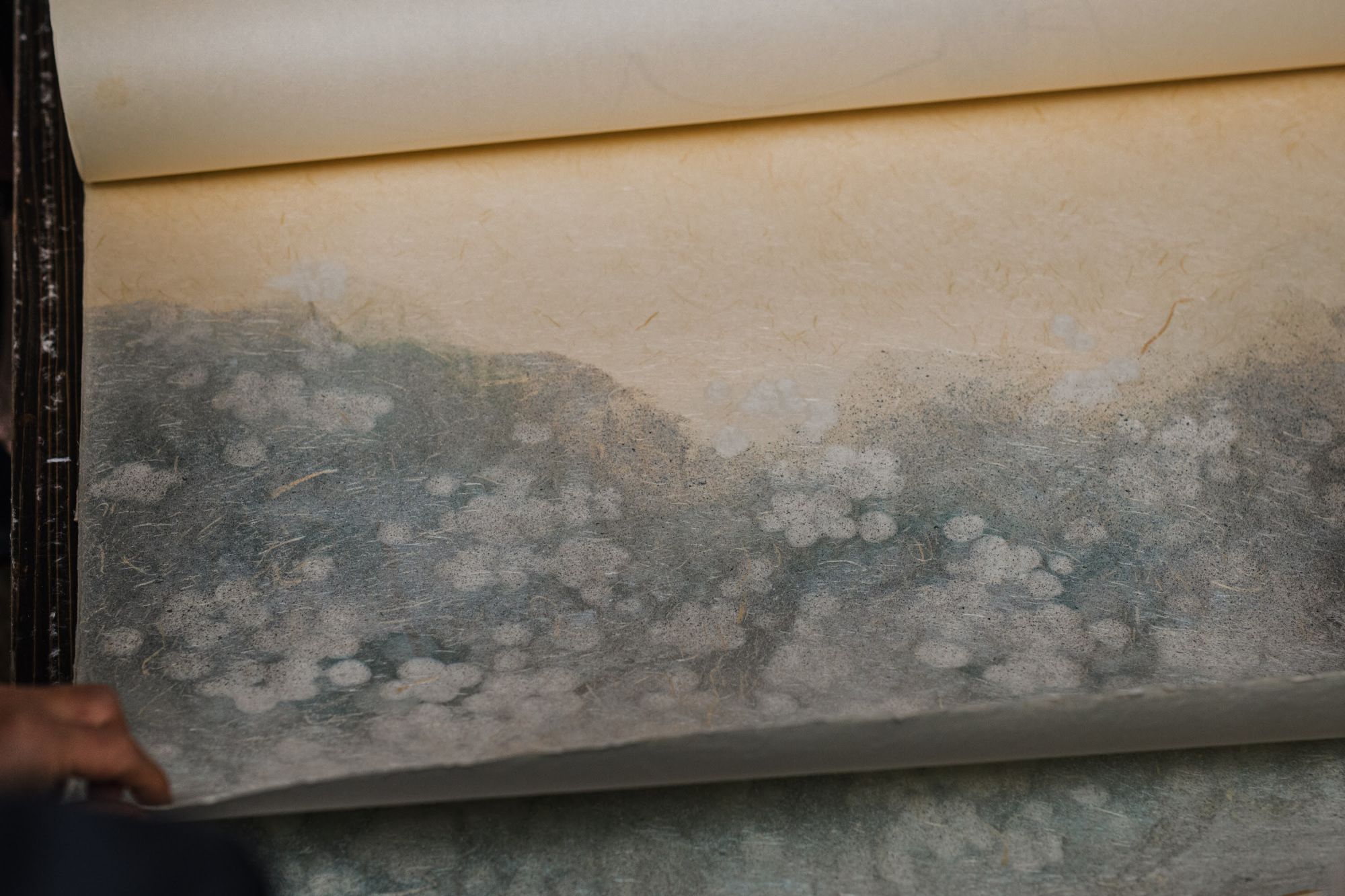
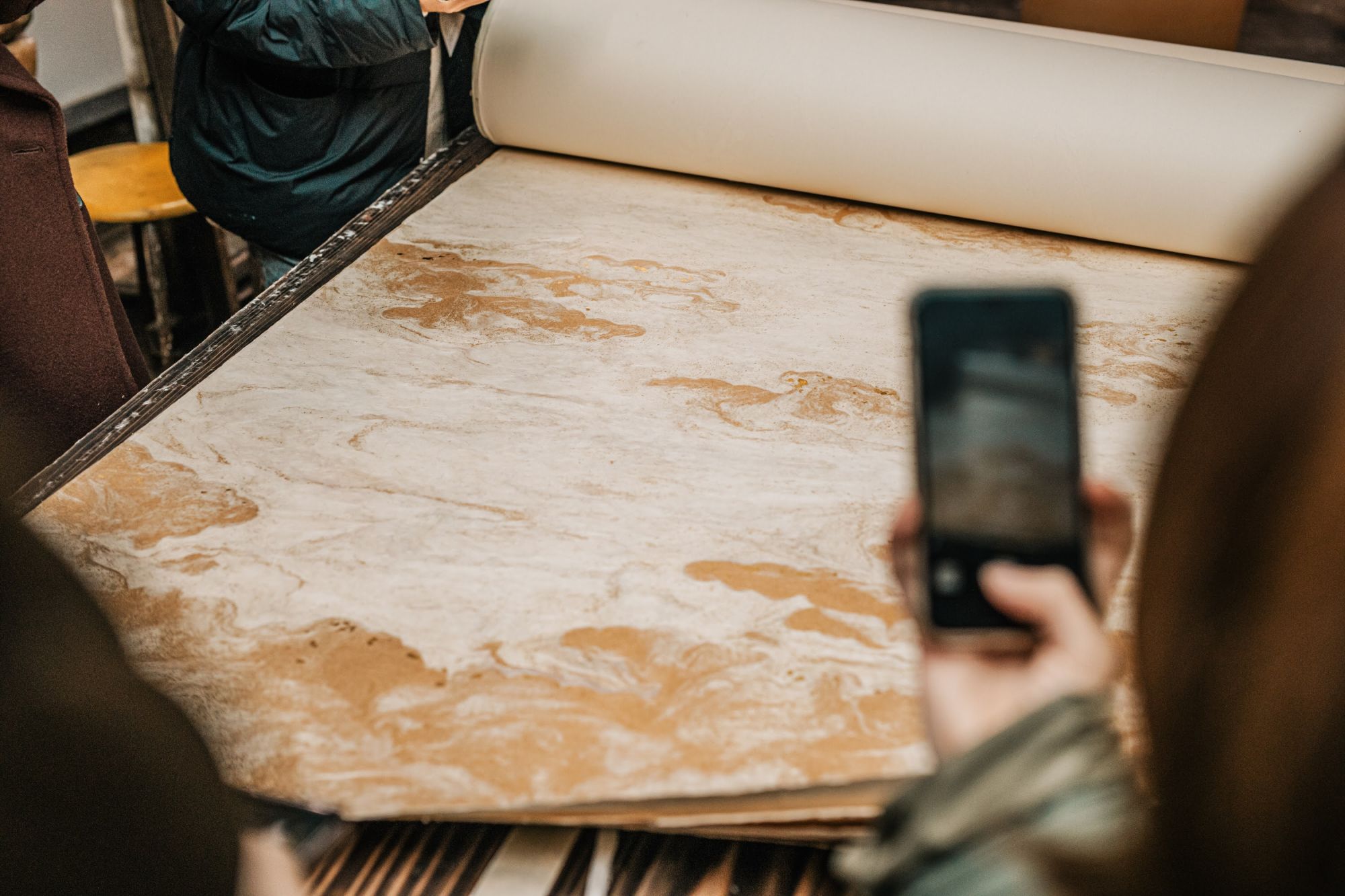
Delicate designs and gradations are also theri specialty.Osada Paper Mills' interior washi paper has been used in various locations in Japan, including the entrance of the Takashimaya Department Store in Nihonbashi, the show window of “GUERLAIN” in France, the entrance of the Osaka InterContinental Hotel, and Narita Airport.
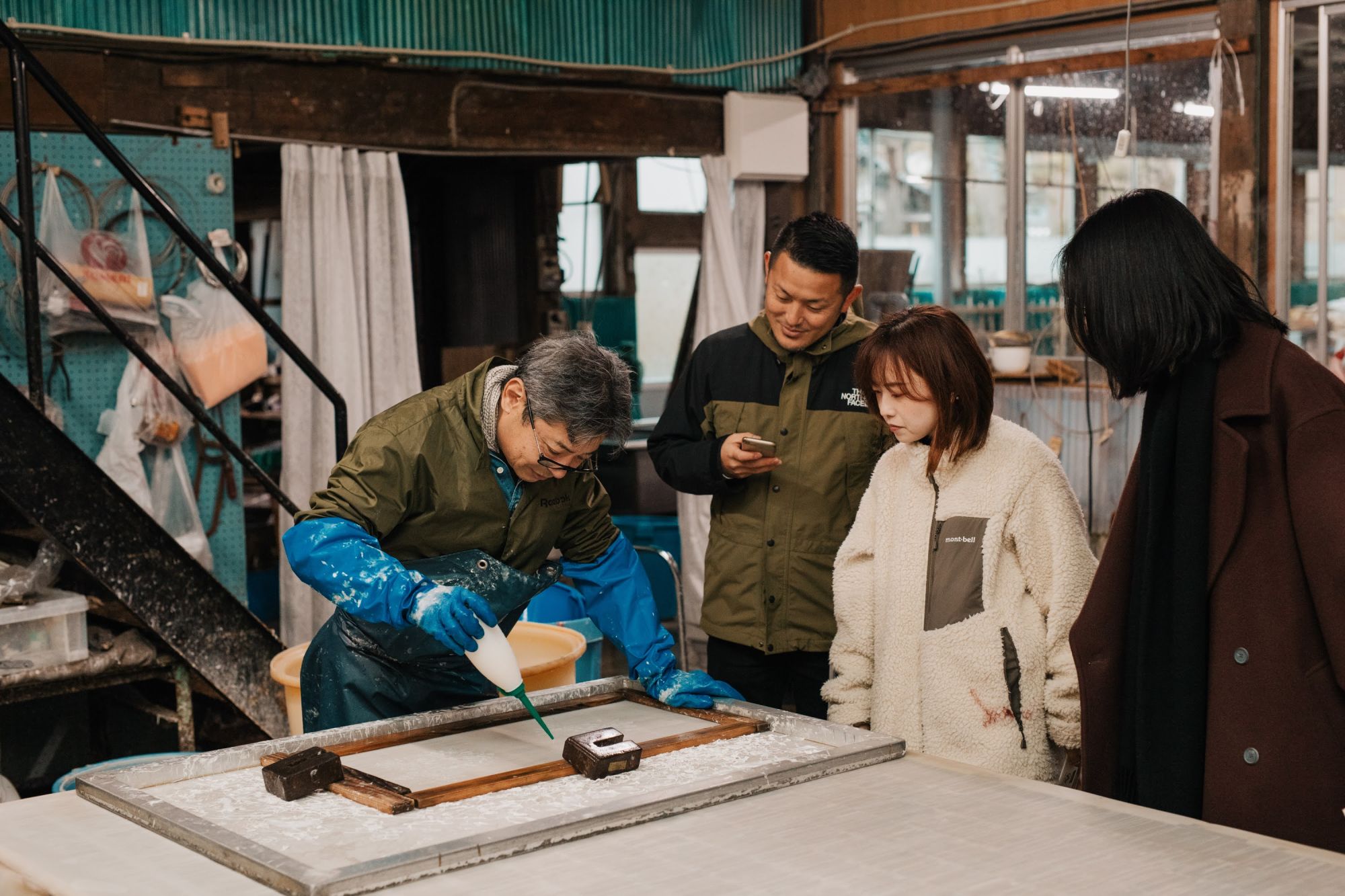
In addition, Kazuya Osada, the owner of the company, developed the “Hiryu” technique, in which sticky raw materials are flown into the air to create a pattern on the washi paper.
Patterns like lace fabrics are also finished as if they were painted.
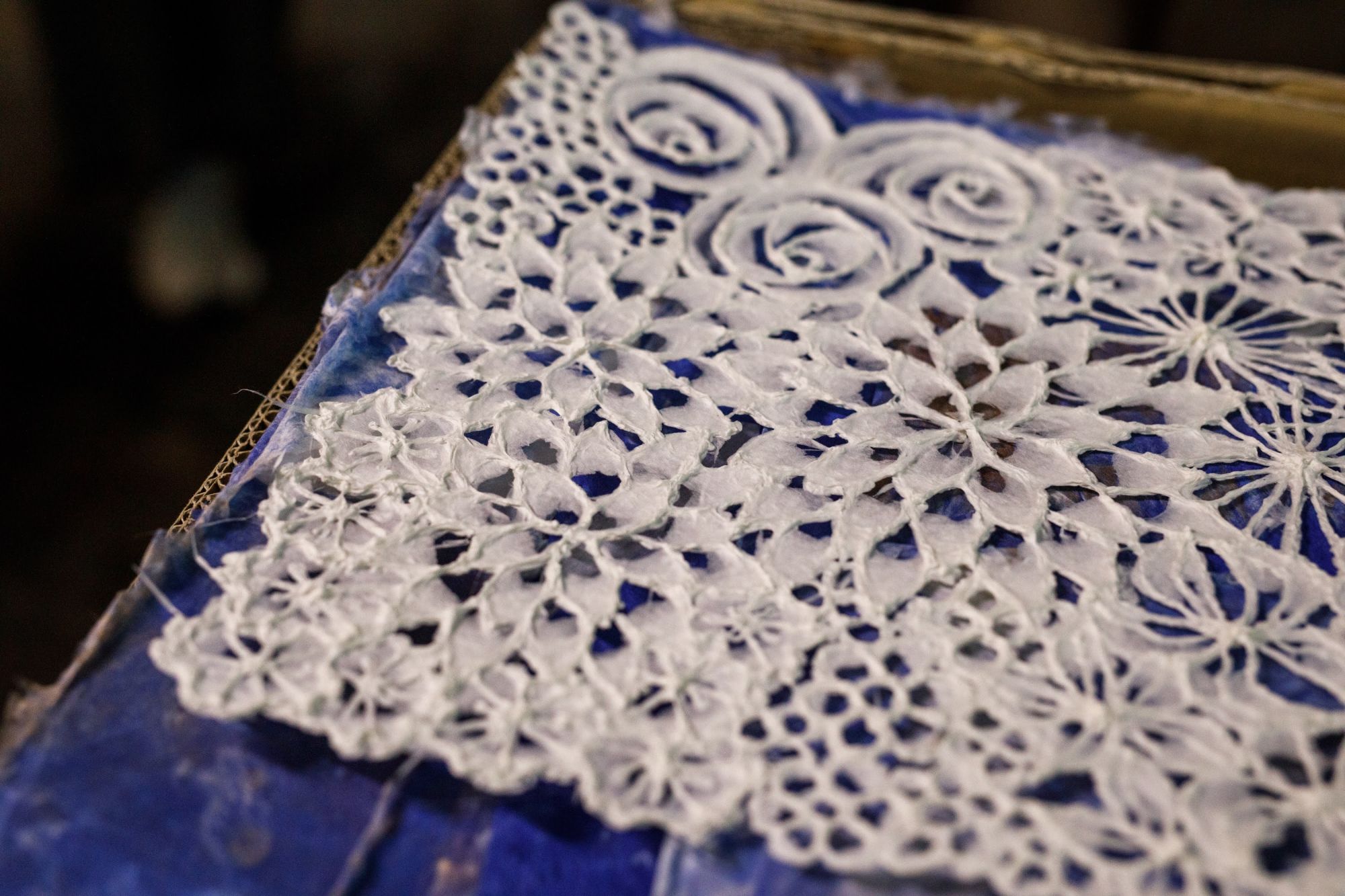
These washi are often used for decorative washi such as tapestries and lampshades.Each sheet of washi is handmade by craftsmen and is one-of-a-kind.
“This Japanese paper could be used in this kind of space!” and let the light shine through it, or layered several sheets of washi together.Everyone at NOMURA Co.,Ltd. seems to have been inspired by the wide variety of Japanese Washi.
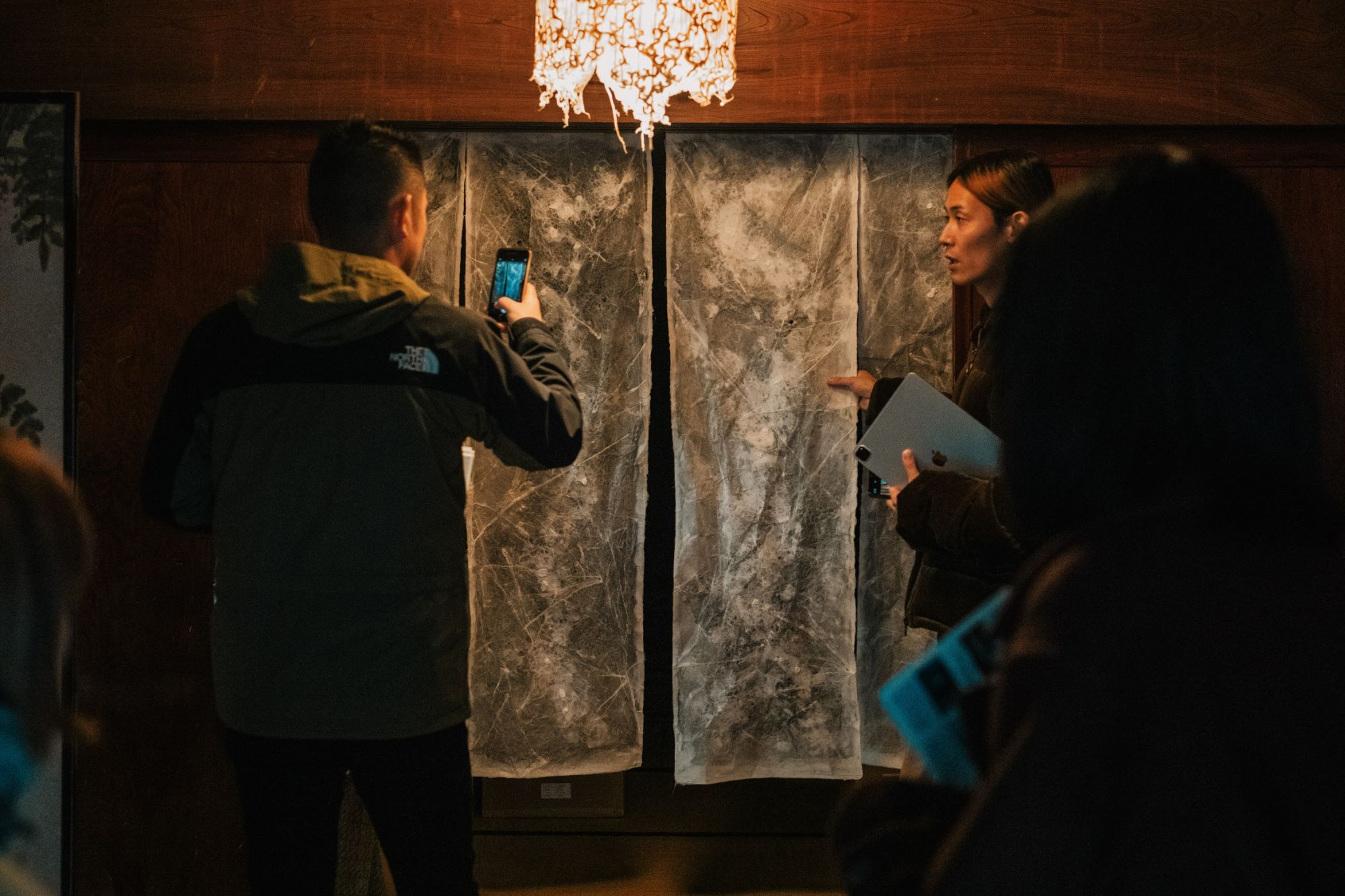
The sun is slowly beginning to set, but the research continues.
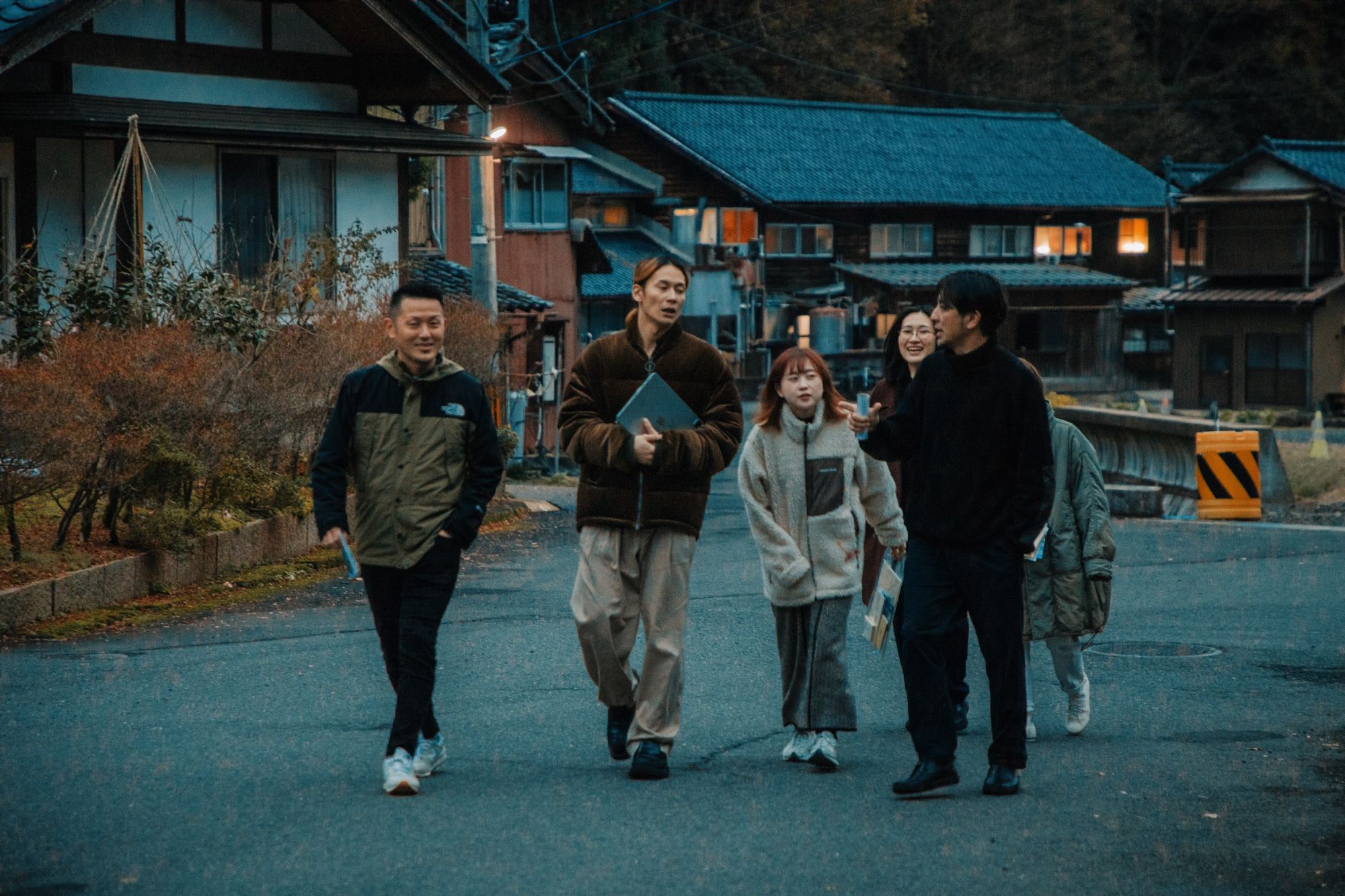
The next stop was “Yamatsugu Paper Mills”, located a few minutes' walk from Osada Paper Mills.Founded in 1868, it is a paper mill that produces handmade art paper (koma-gami).
Bijutsu koban-gami is a general term for Japanese paper with traditional decorations used in Japanese accessories.This colorful washi has been made in Echizen since ancient times.
The essential part of koma-gami is the “hikkake” (hooking),” said Mr. Hiroya Yamashita (top photo), a traditional craftsman.
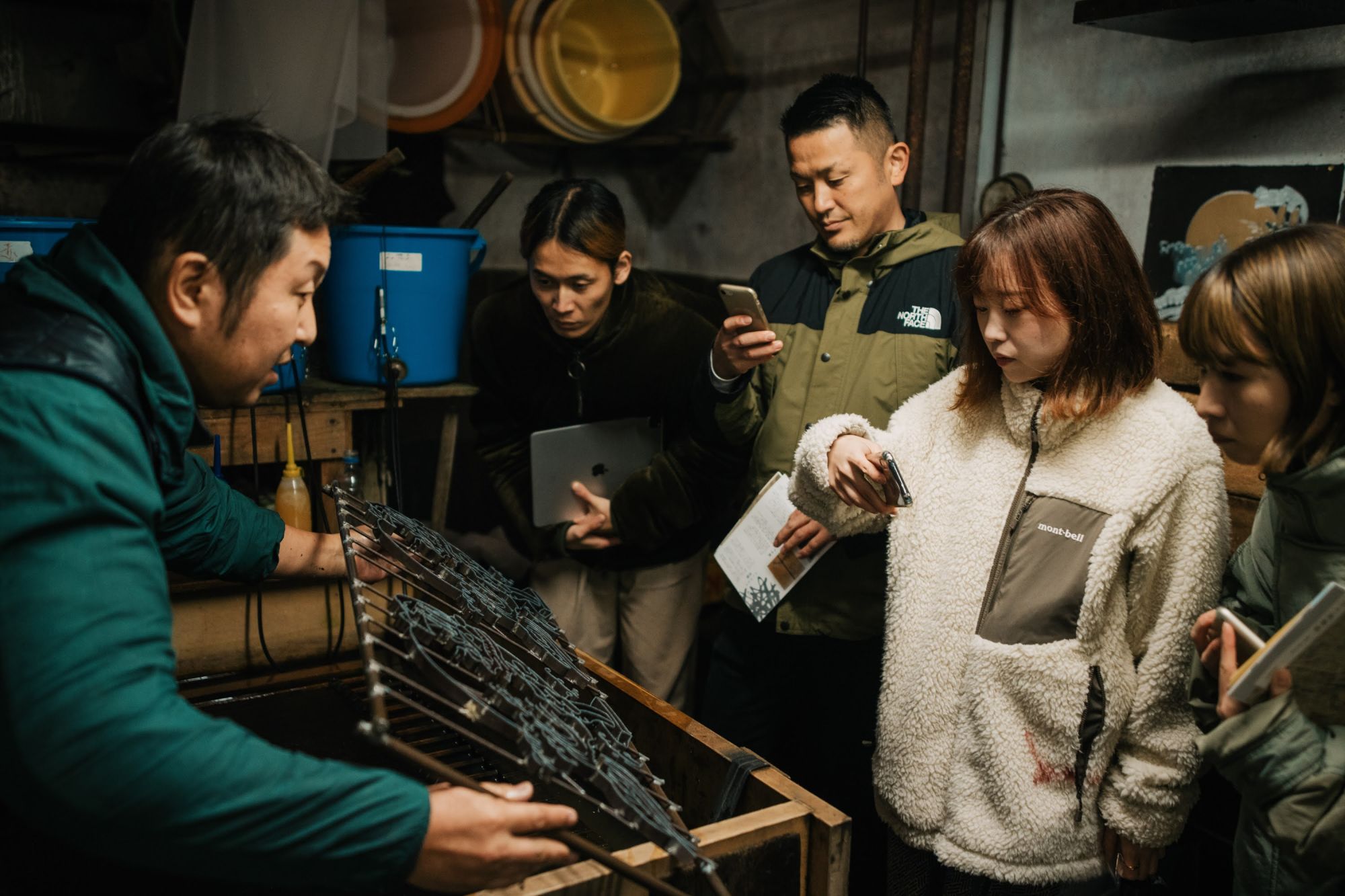
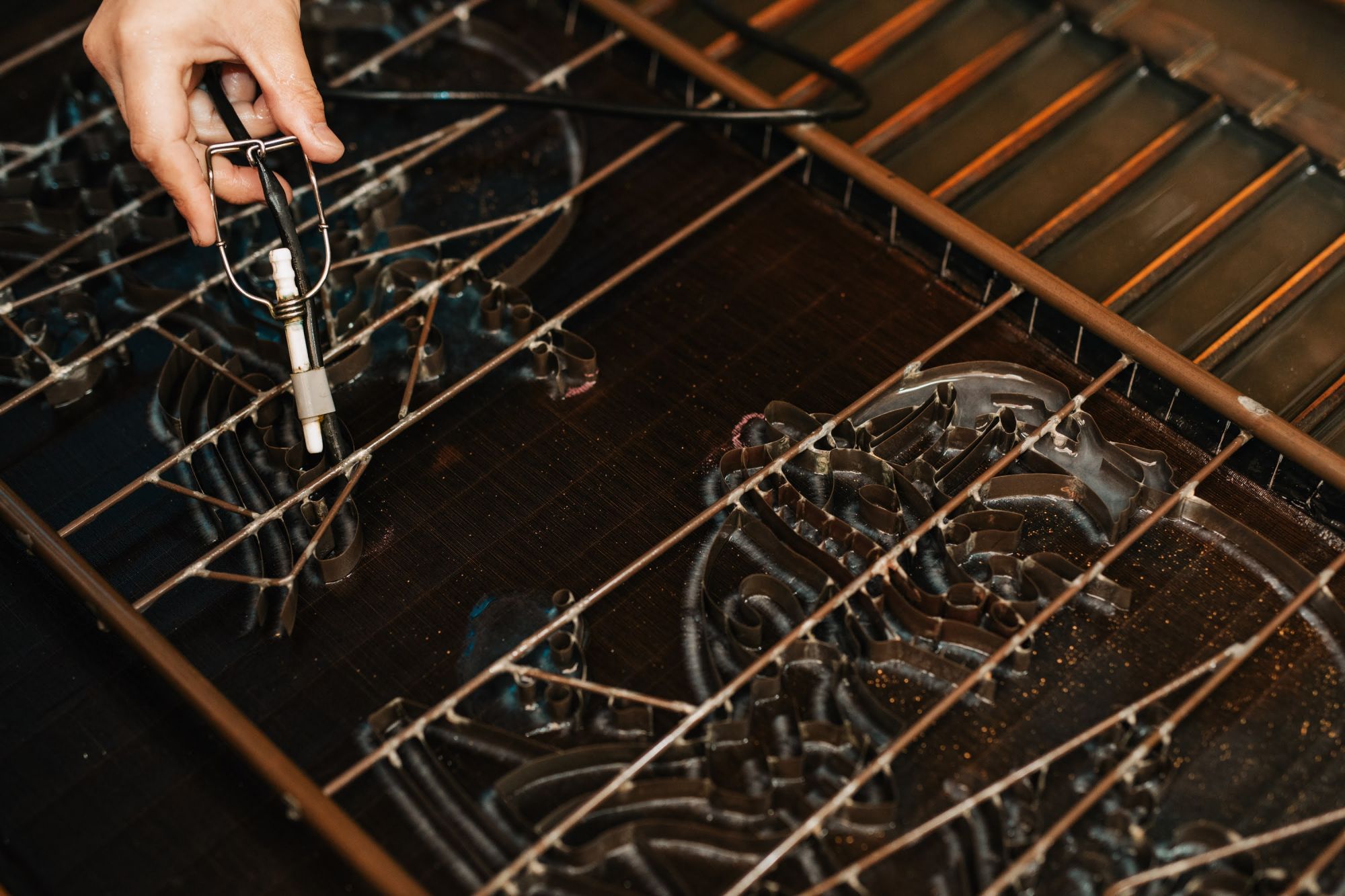
"HIKKAKE” is a technique in which the raw materials of washi are ‘hooked’ onto a thin metal mold that forms the outline of the pattern and adheres to the bamboo screen, which is then covered with the base paper to create the pattern.
It can also be colored like a coloring book.
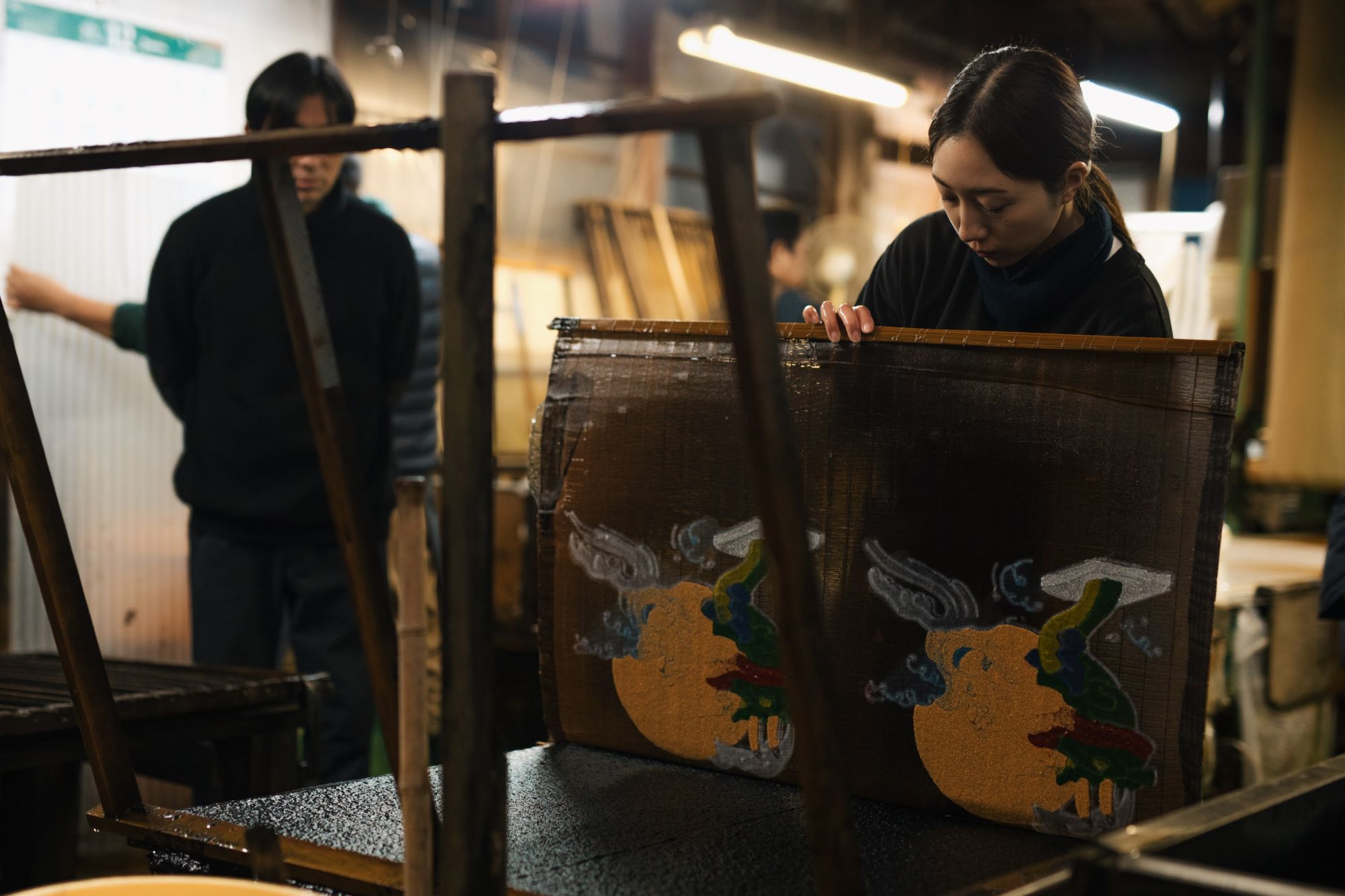
After the pattern is transferred to the bamboo screen, it is laid on top of the base paper and then strained together to complete a sheet of patterned paper.The patterns transferred from the molds that catch the fibers are very beautiful with a softly spread fiber feel and luster, and the various expressions can be seen from different angles.
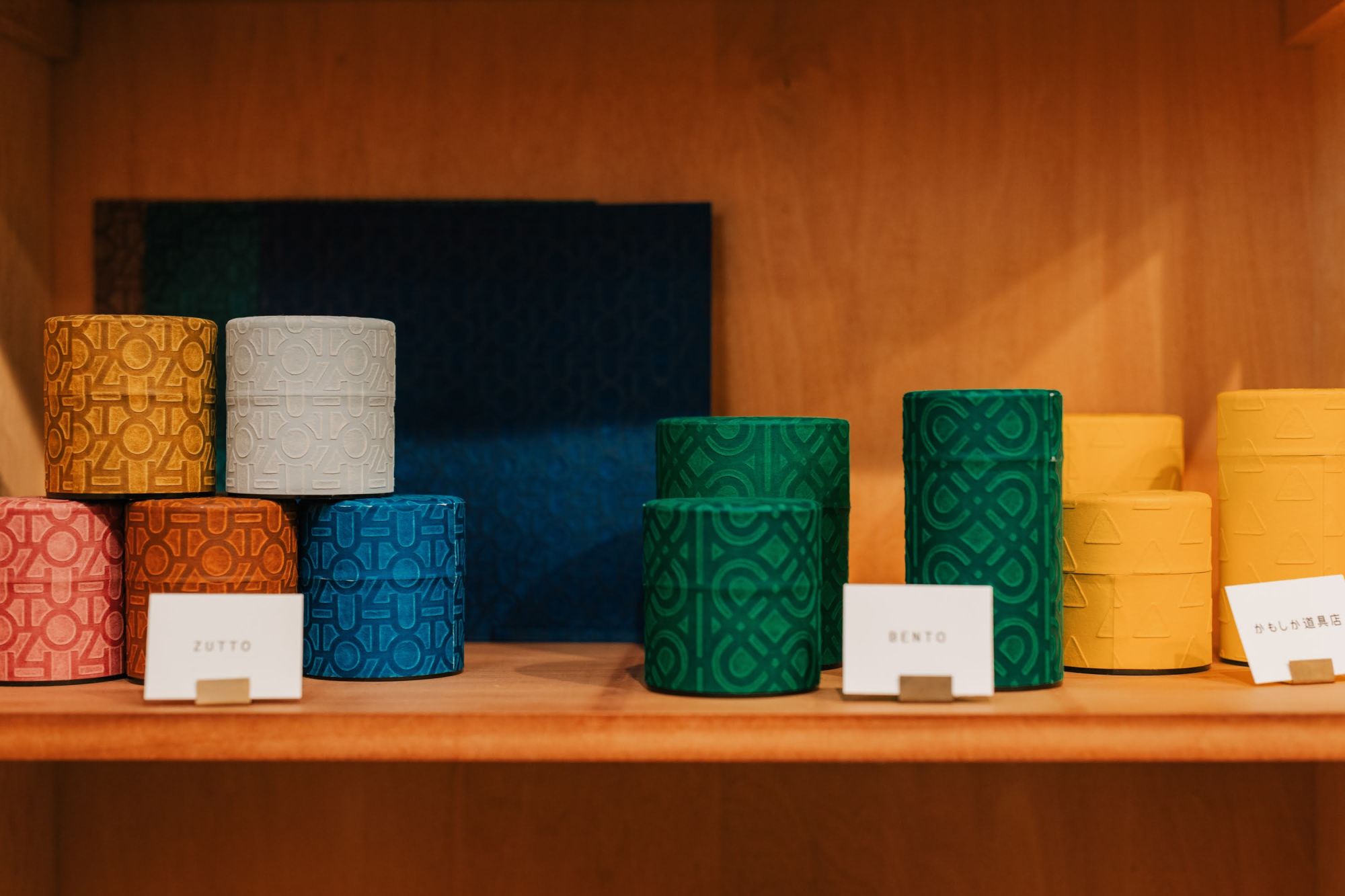
In recent years, the company has been actively developing new techniques, such as fade-resistant washi for the overseas market and 'uki gami' (floating paper), which uses the kata-oshi technique to create a distinctive pattern with an edgy look.

Floating paper comes in many patterns and colors!Some patterns were created in collaboration with designers, and many are semi-ordered.Tea cans and business card cases made of floating paper are also popular.
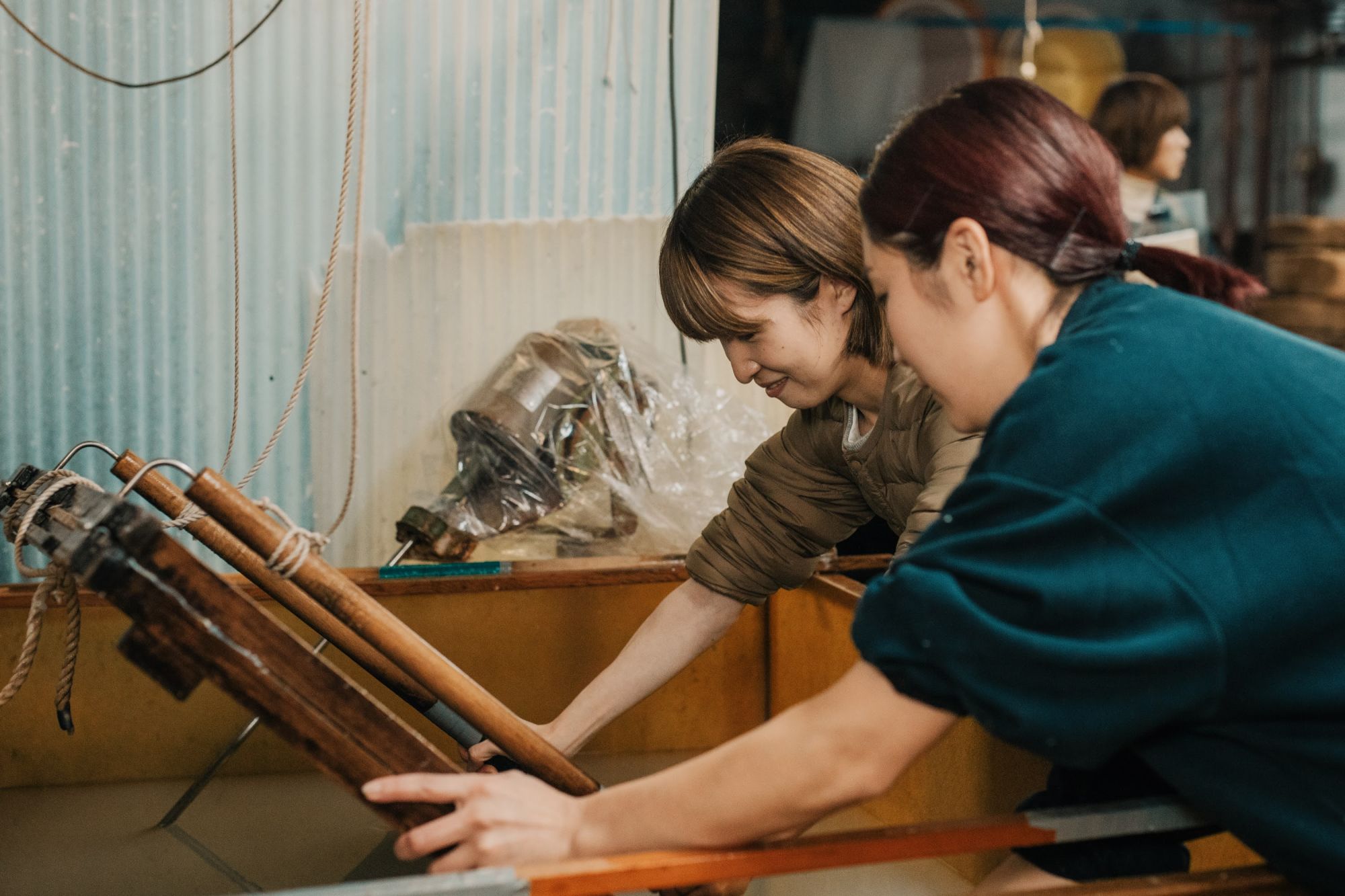
At Yamatsugu Paper Mills, visitors can try their hand at papermaking.Craftsmen make paper very easily, but it is extremely difficult to make the paper uniformly.Everyone at Nomura Co., Ltd. also found washi making interesting, and at the same time, felt that craftsmanship cannot be mastered overnight.
After visiting the factory of artisans who make various types of washi, we will go to a workshop specializing in paper processing.At "Shimizu Shiko", washi is processed after straining to give it a variety of functions.
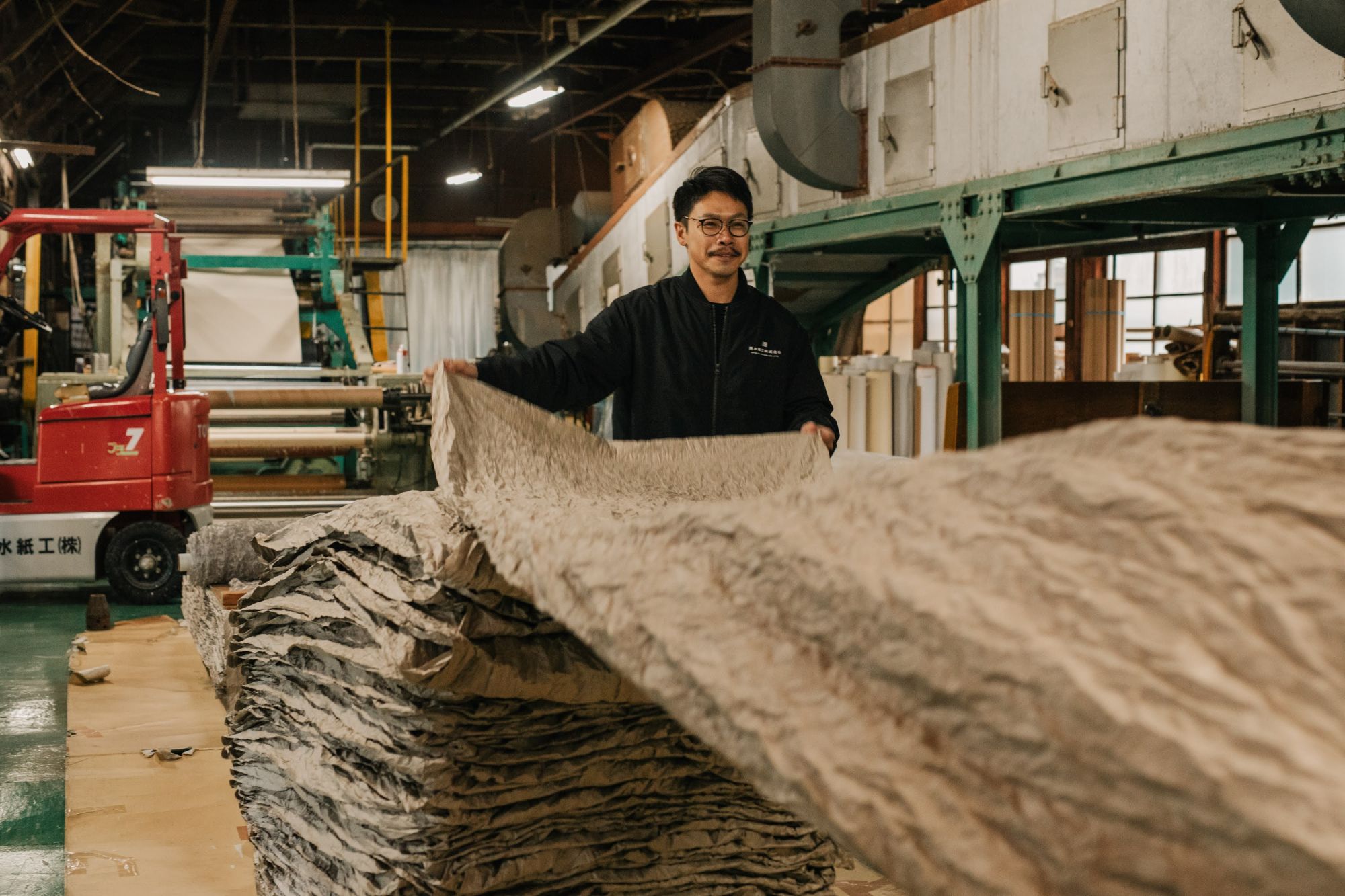
Mr. Satoshi Shimizu, the representative of the company, took us to the production site of “rubbed paper,” which is made by rubbing paper to give it a unique texture and durability.Crispy paper is transformed into something like soft cloth by passing it through a machine or rubbing it by the craftsman's hand.There are variations in the way the fabric is rubbed, whether randomly in the vertical and horizontal directions or in one direction, as well as in the fineness of the rubbing, resulting in different expressions.
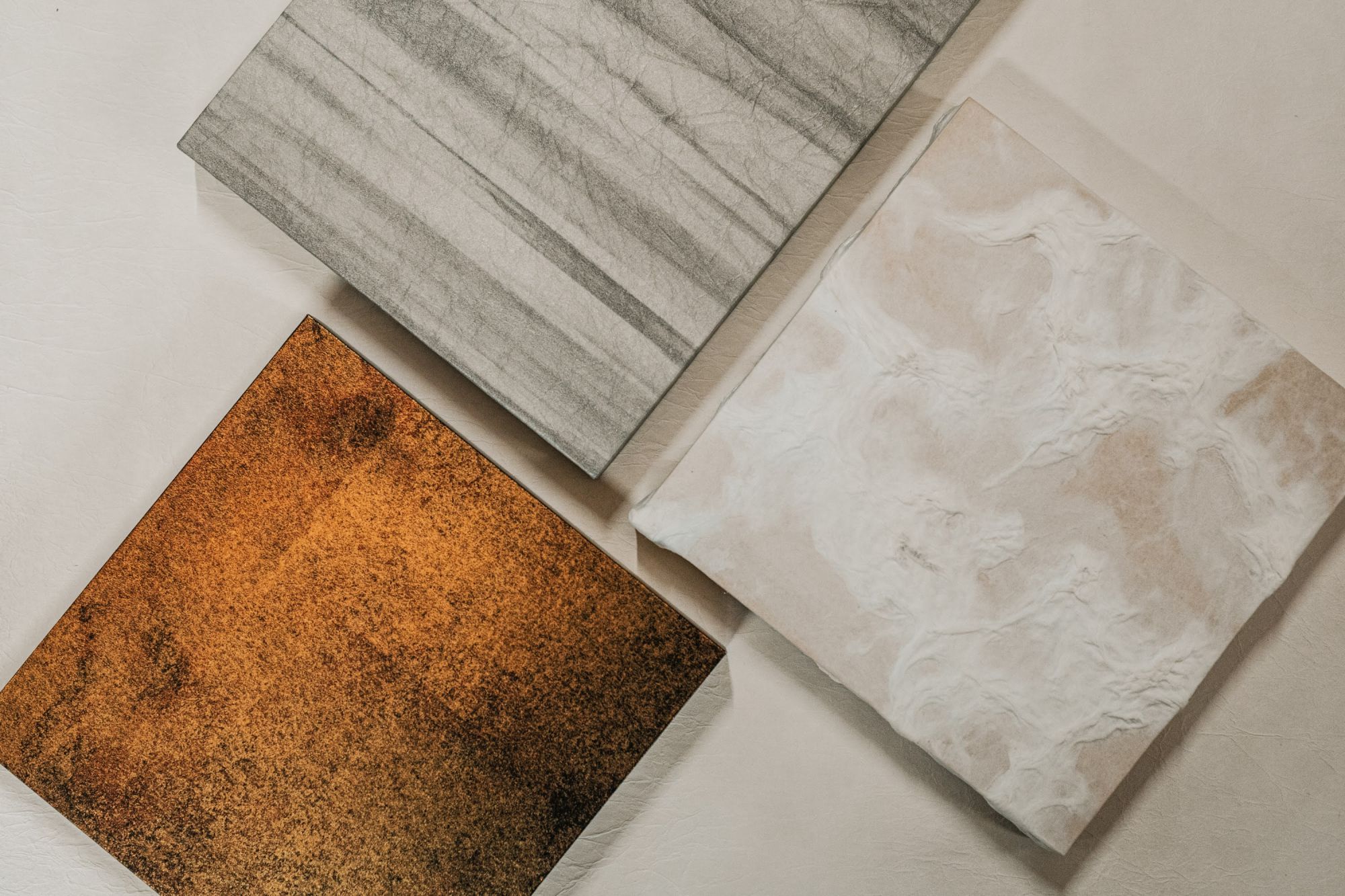
Shimizu Shiko's techniques, such as watermarking paper and laminating paper together, are flexible.Water repellency and antibacterial effects can also be added.
The flame-resistant paper, which is given non-flammable and flame-retardant functions, has been certified in accordance with the Building Standards Law.Recently, it is often used for architectural scenes such as wallpaper.
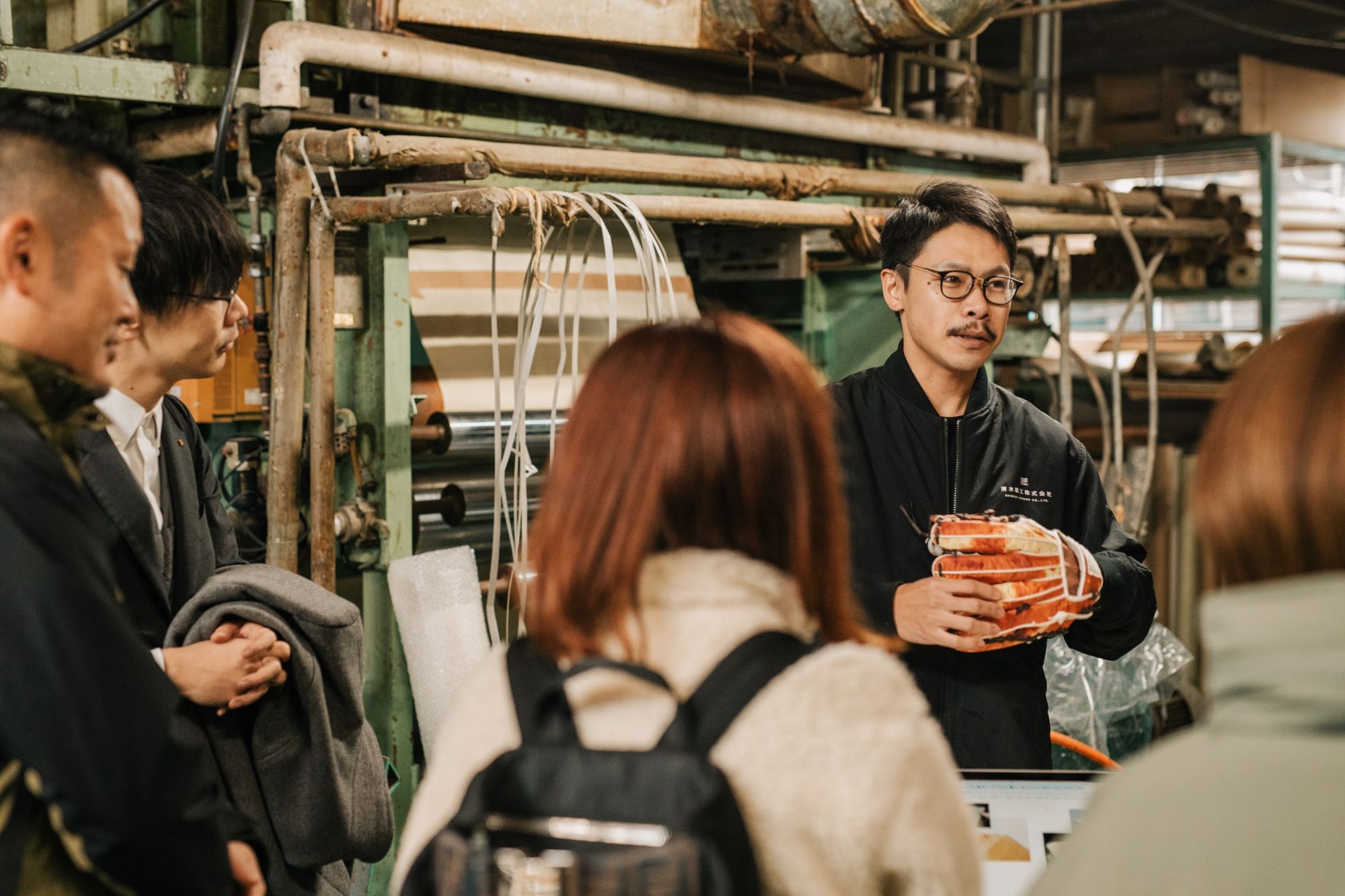
These days, as a “washi concierge,” Mr.Shimizu selects the paper that best suits the client's needs, and sometimes develops new papers.One of these efforts is the “washi paper glove” that Mr. Shimizu is holding in his hand.It was created in collaboration with the sporting goods manufacturer “Mizuno,” and as the name suggests, it is made entirely of Japanese paper, not leather.
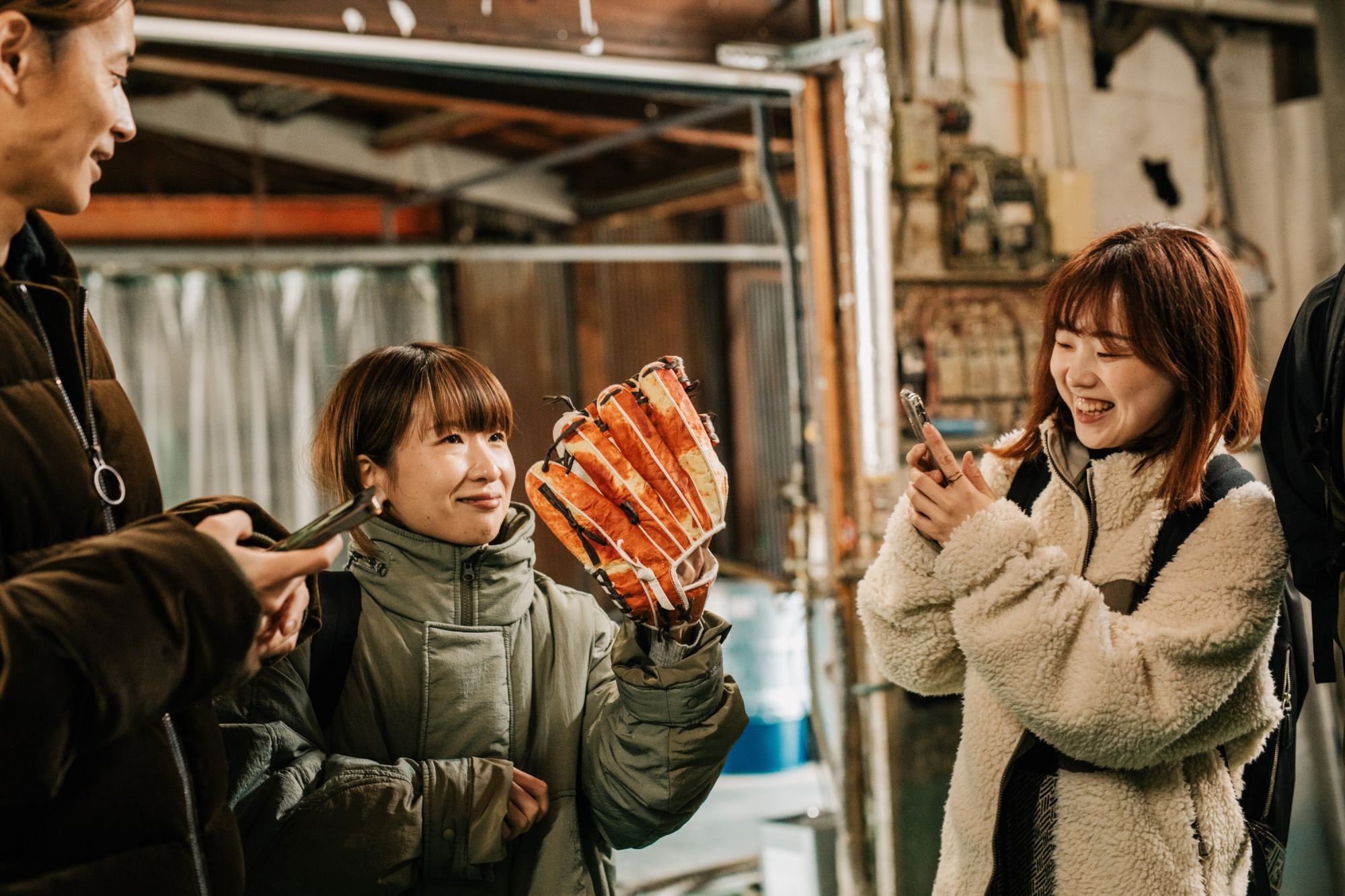
グMr. Shimizu selects the best Japanese paper for each part of the grab.These products are the result of our thorough knowledge of the craftsmen in the area of production.When I actually held it in my hand, I was surprised at its leather-like softness and durability!
We realized the possibilities of paper and its processing, which is not limited to writing and wrapping.
.jpg)
The sun has completely set and night has fallen.The last stop on the first day was Sugihara Washi Store.As a wholesaler of washi, we plan and sell Echizen washi throughout the world in cooperation with artisans in the production area.
.jpg)
Yoshinao Sugihara, the representative of the company, is a “sommelier of Echizen washi".Reflecting on the washi and craftsmanship we saw today in the various workshops, we were given an explanation by Mr. Sugihara.
When asked about the characteristics of the production area, Mr. Sugihara replied, “Many Echizen washi craftsmen are willing to try new things”.
"In this area, not only young craftsmen, but even living national treasures who have passed down their skills for hundreds of years bring us new paper, saying, ’I tried to make this kind of paper.’ said Mr.sugihara.
If we keep doing the same old thing, we will never grow."Let's try something new for now!” and a culture of taking on new challenges is deeply rooted in this region.
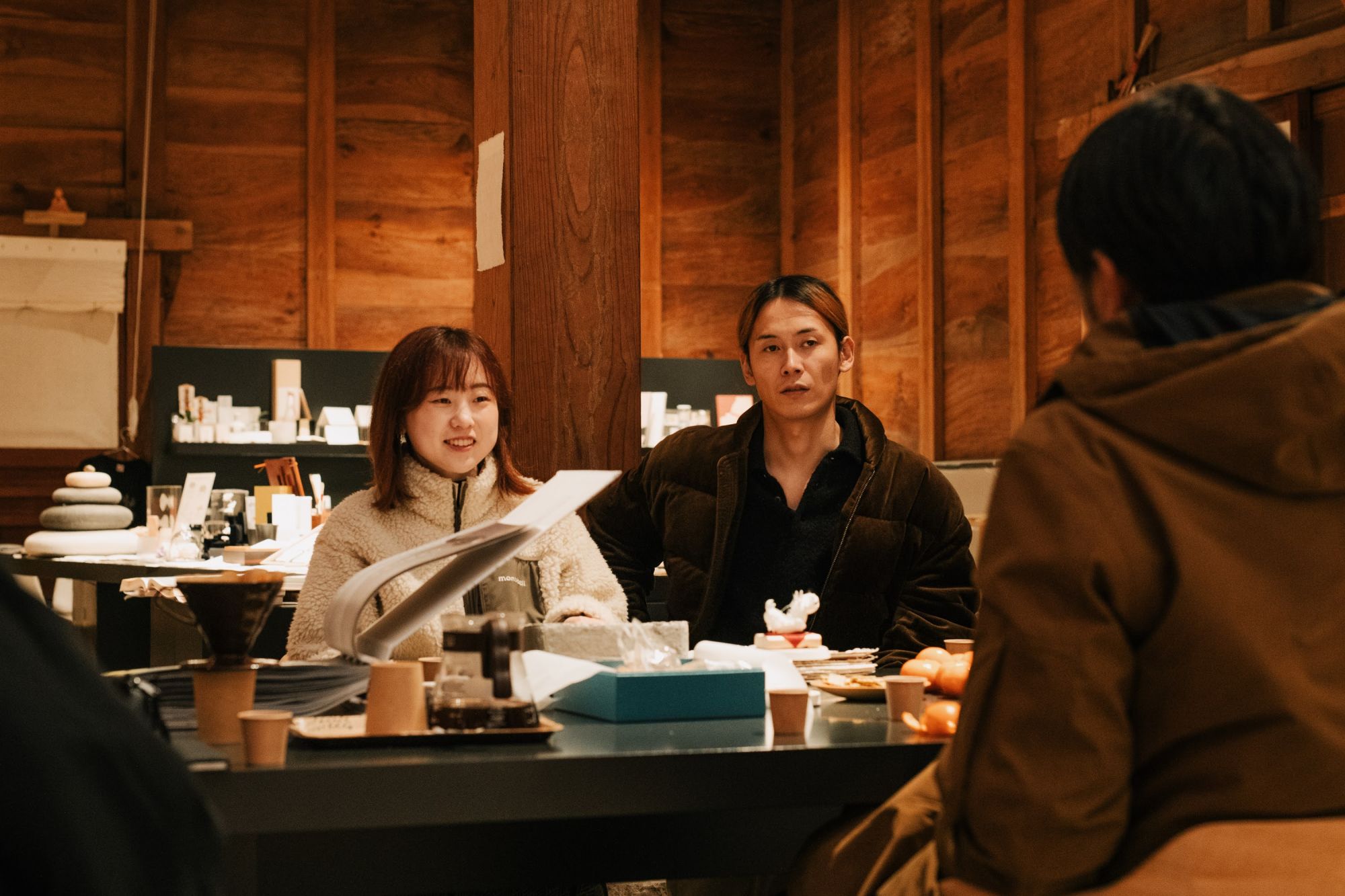
"Seeing the product in a catalog or sample is completely different from actually seeing it being made at the production site.” "We want developers and wealthy clients to see this technology.” “It is light, strong, and rich in shape and expression. I think it's a material that fits the zeitgeist.” NOMURA Co.,Ltd. staff share their various impressions, including the following.
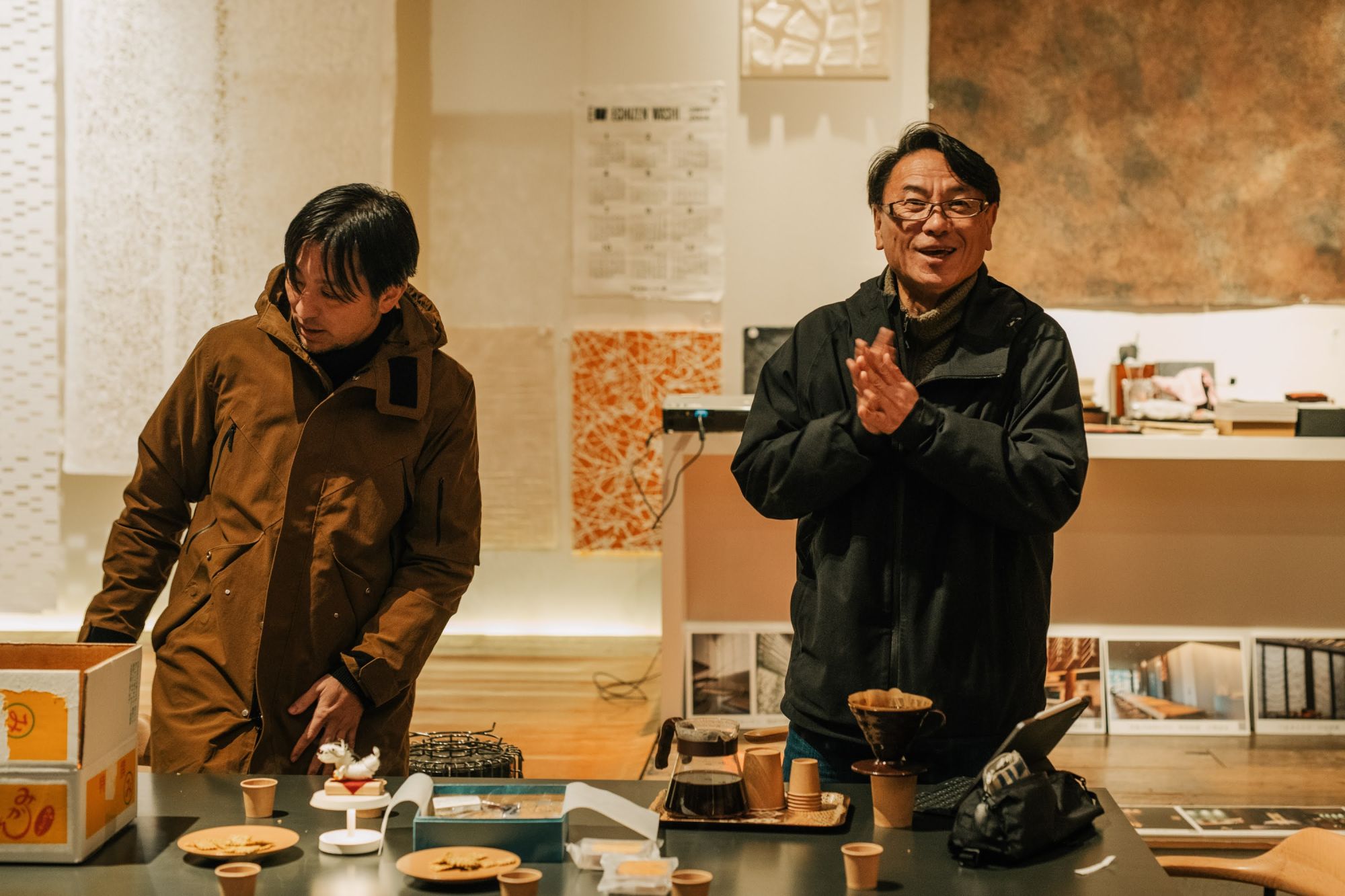
“In recent years, the demand for interior design has been high, and more and more people from overseas are visiting this production area.The Hokuriku Shinkansen line will be extended to Fukui and Tsuruga, and access from Tokyo will become more convenient. I hope that you will expand your possibilities while coming into direct contact with craftspeople,” Mr.Sugihara also expressed his hopes for the future.
After the dense first day, the next day we will visit other production areas besides washi paper.The first place we came to on this day was “Echizen Ceramica” in Echizen City.In a spacious factory surrounded by An undeveloped woodland area near a village, “Echizen Tiles,” which are indispensable for buildings in Hokuriku, are made.
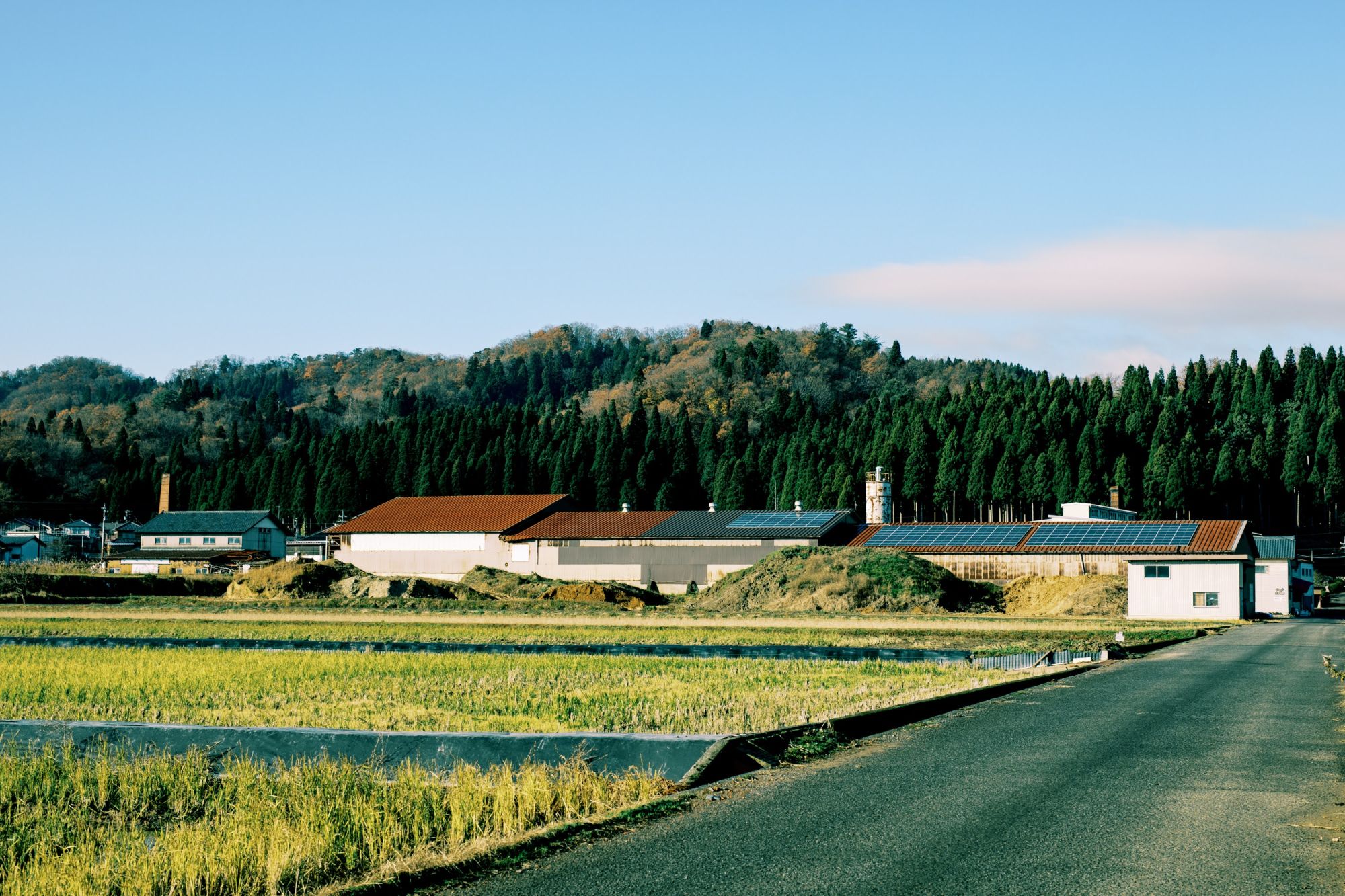
Echizen Tiles are traditional tiles made in the Echizen area. It came into common use around the Edo period (1603-1867) and spread to Tohoku and Hokkaido by the Kitamae Ship.
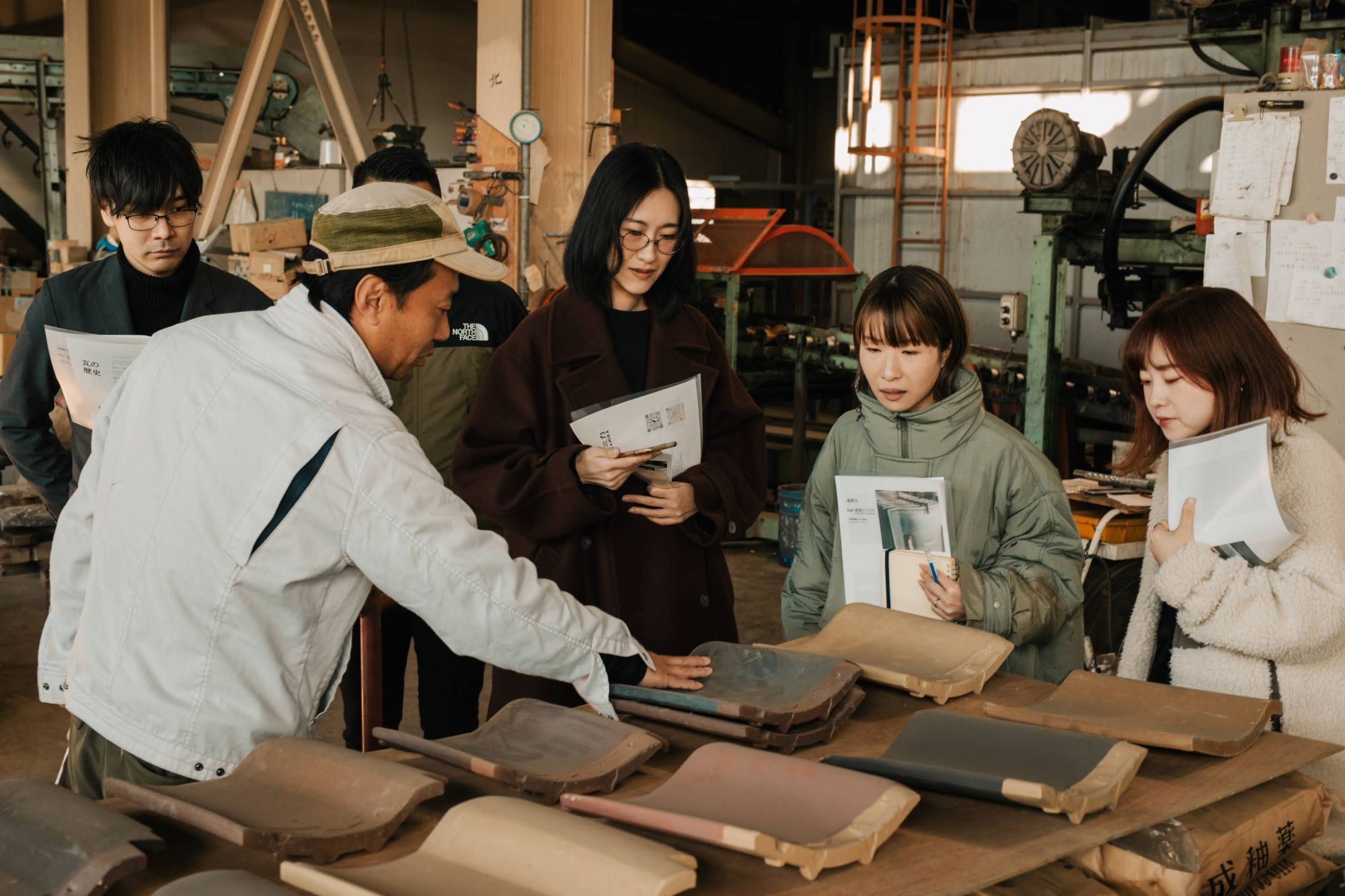
Echizen tiles are characterized by their excellent cold resistance.They have refined their own technology to cope with the harsh climate of Hokuriku.Reduction firing at a high temperature of around 1,200℃ provides low water absorption and strength to withstand heavy snow.Its strength is nearly double that of the standard set by the JIS standard.
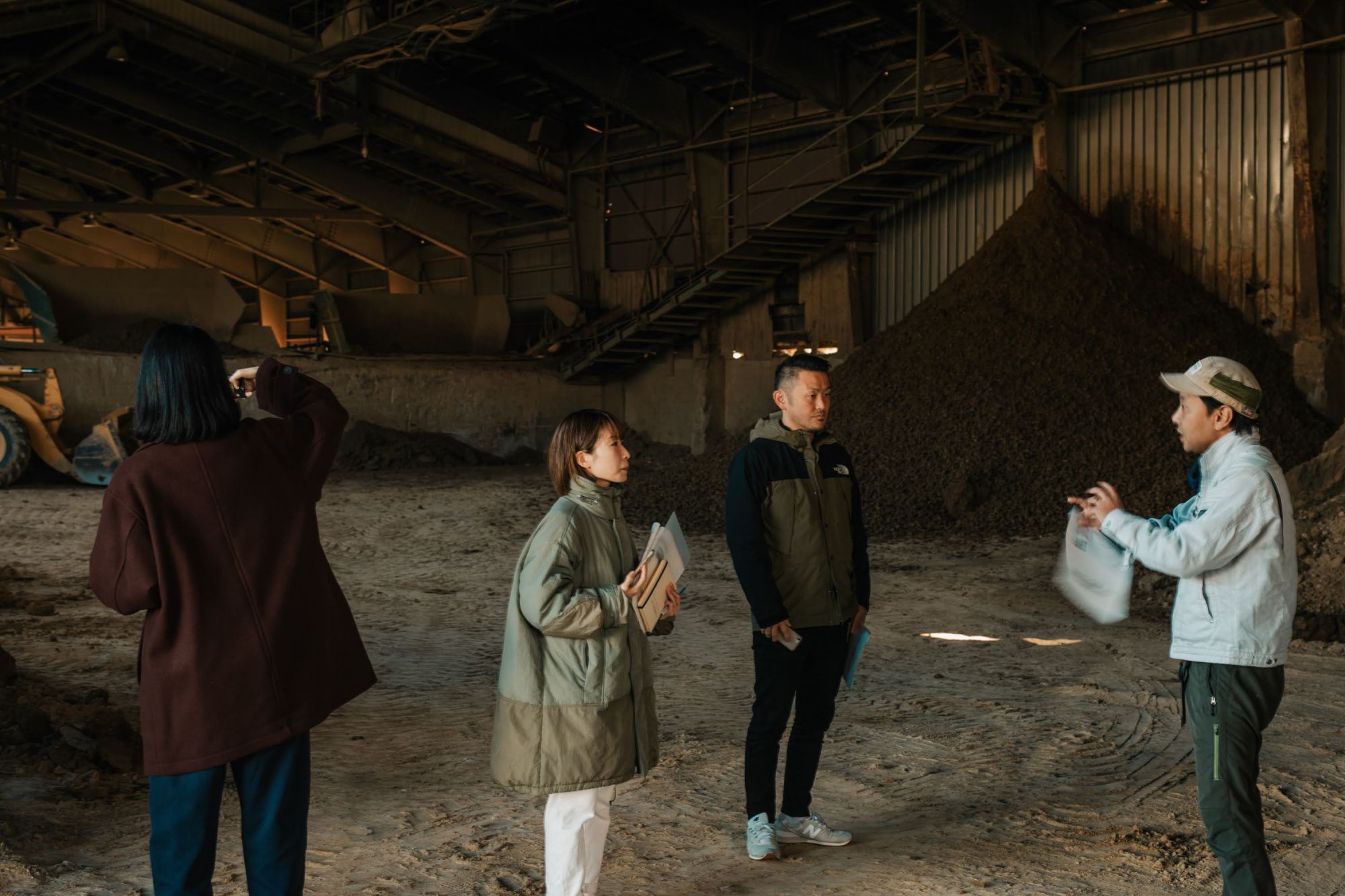
A warehouse as large as a school gymnasium is filled with piles of various types of clay.Clay is transported by large excavators and kneaded into a unique blend suitable for Echizen tiles.
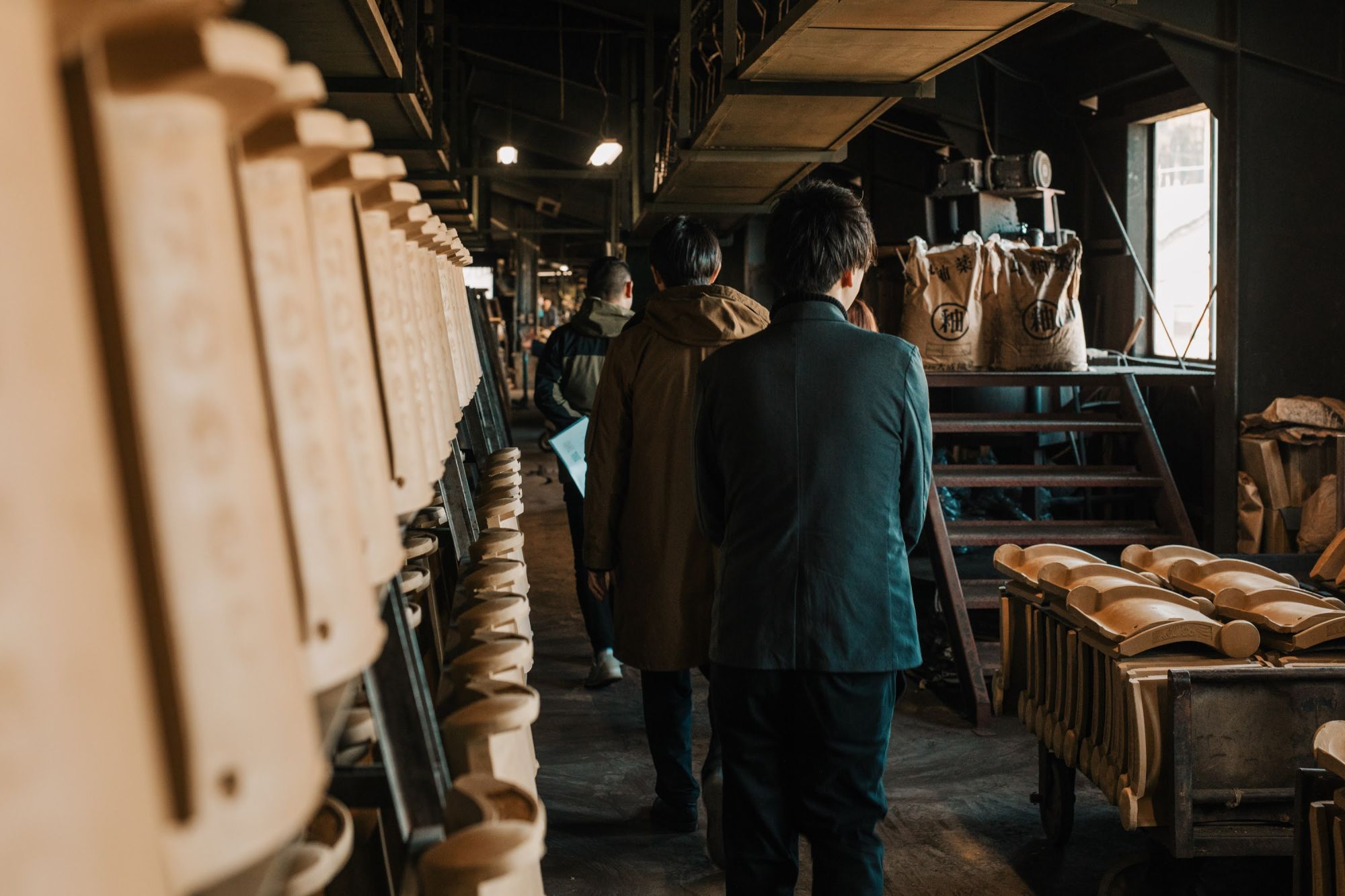
The mixed clay is pressed and molded into the shape of a roof tile.The sight of tiles being carried one after another on a large conveyor belt is a sight to behold!
After drying for a while to remove further moisture, it is unglazed, glazed, and fired.

The maximum temperature of the kettle, which is a long lane, is over 1200 degrees Celsius.The roof tiles are baked slowly and deliberately using a method known as “reduction firing".
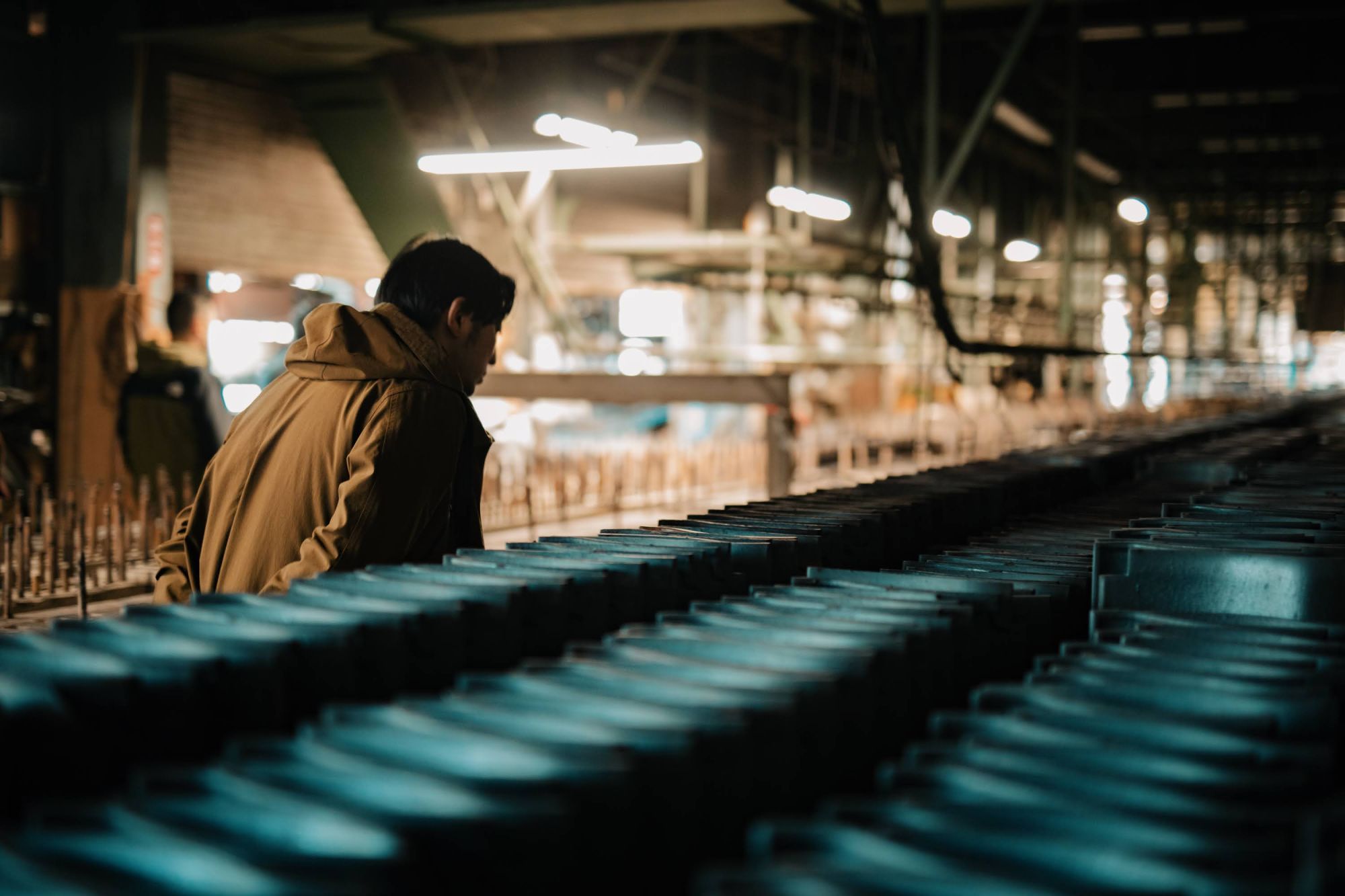
The baked tiles are the familiar “silver rat” color.The subdued coloring blends well with nature.Echizen Ceramica has an integrated system that handles everything from manufacturing to sales and roofing.Tiles are used to decorate all kinds of buildings in Fukui, including not only ordinary houses, but also temples, shrines, public facilities, and cultural assets.

Furthermore, Echizen Ceramica is actively engaged in product development, and also manufactures and sells tiles, bricks, and other building materials for exterior use, utilizing its roof tile manufacturing technology.The tiles, which are not only durable but also well-designed, match a variety of spaces, both Japanese and Western.
"Tiles had always had a traditional, austere image, but my impression of them has changed.” It can be incorporated into a “modern space. Depending on the shape and the way it is assembled, it will be possible to create a wide variety of interesting expressions,” The Nomura Co., Ltd. staff commented. Echizen Ceramica and they were exchanging ideas about ideas for the future.
From here, we will leave Echizen City and tour the manufacturing sites of Fukui.
Echizen City is home to Echizen washi paper, Echizen hammered blades, and Echizen chests, while neighboring Sabae City and Echizen Town produce traditional crafts such as Echizen lacquerware and Echizen pottery.It is also known as a very rare area in Japan where a total of seven local industries such as “textile” and “eyeglasses” are concentrated within a 10-kilometer radius.
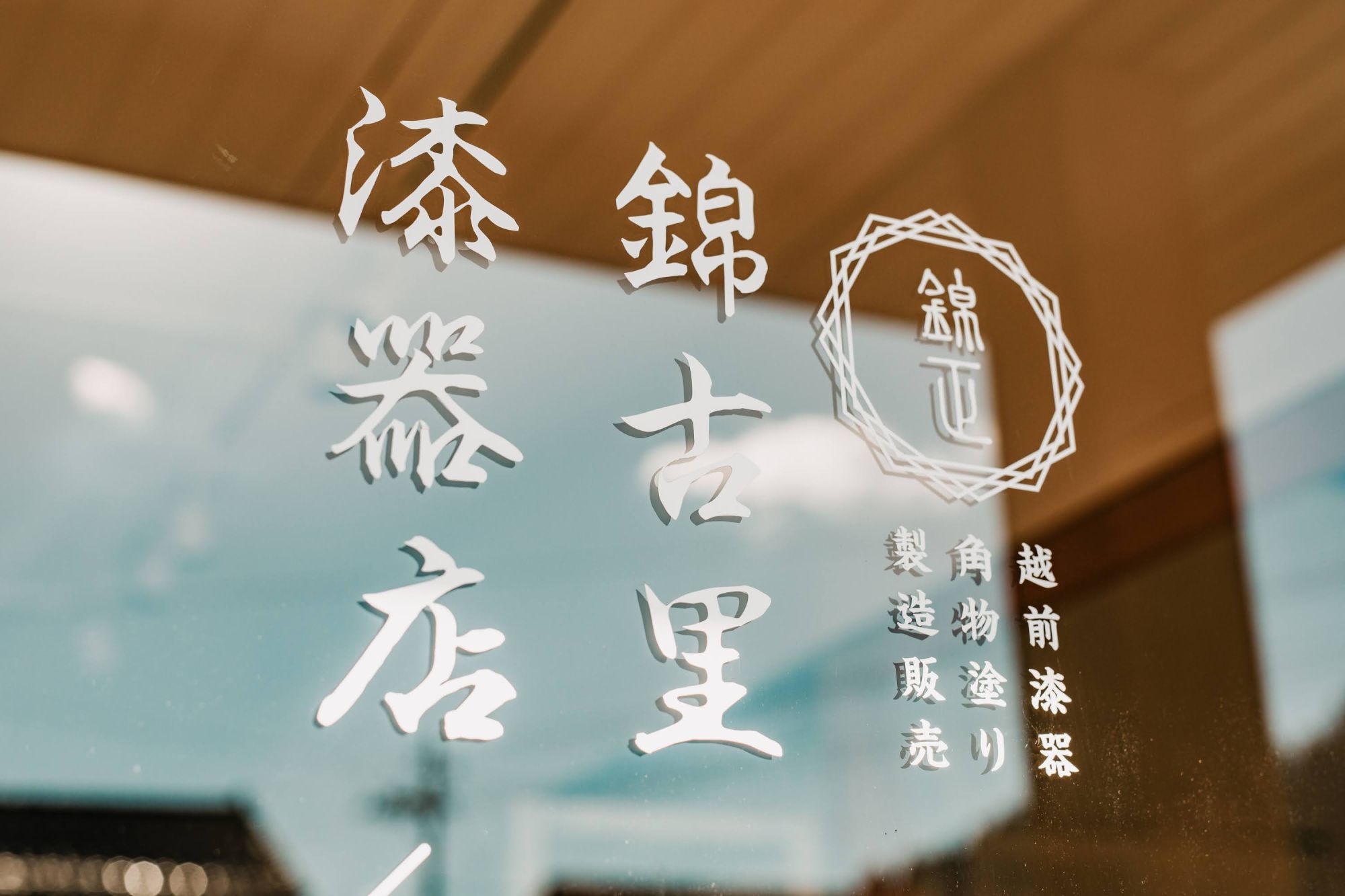
Next came Kinkori Lacquerware Store in the Kawada district of Sabae City, a production center of Echizen lacquerware.
Founded in 1929, the company manufactures, sells, and repairs “kakumono,” a type of lacquerware that includes a small dining table and stacked boxes.
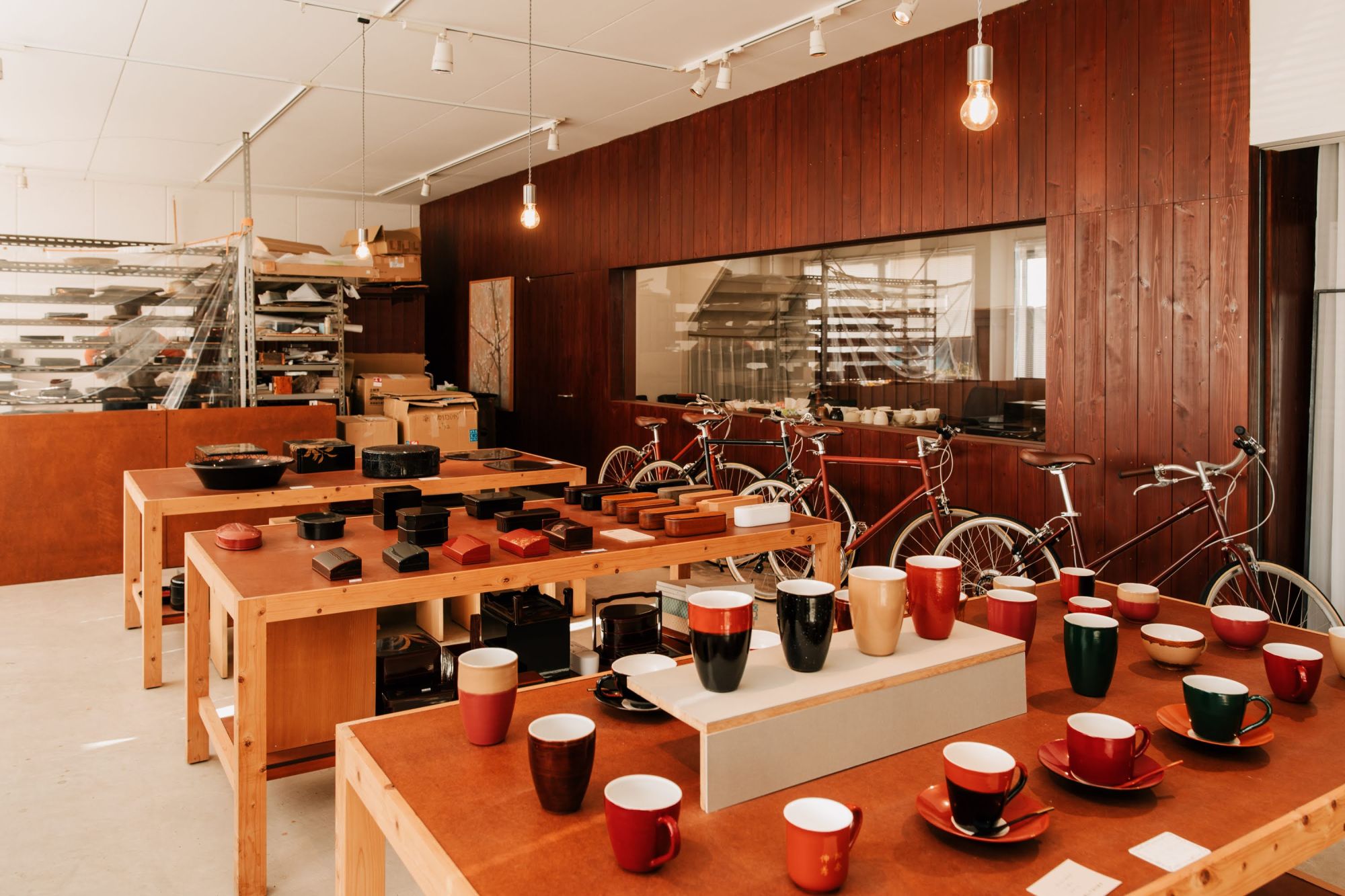
When we visit the workshop, we will see lacquer ware and lacquer products of various sizes, and we can also observe the actual work in progress in the back of the room. The brown walls of the workshop are all lacquered.
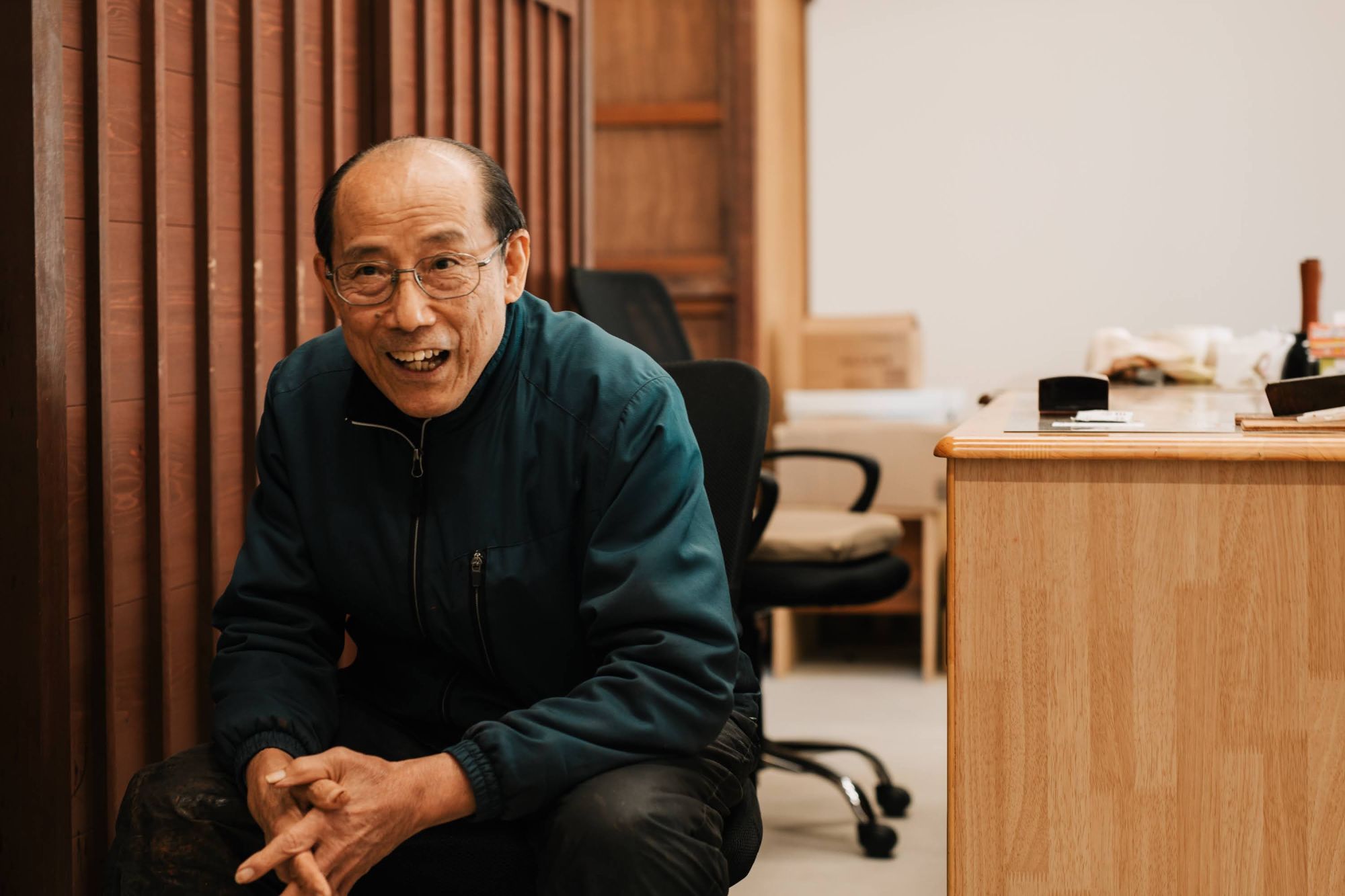
Masataka Kinkori, the third generation, is a veteran craftsman with about 50 years of experience.While opportunities to use lacquerware in daily life are decreasing, Kinkori is exploring new ways of lacquering.
"Echizen lacquerware has a history of about 1,500 years.However, it is said that even as far back as the Jomon period (710-794 CE), it was used in Japan to repair cracks and holes in ornaments and pottery,” says Mr. Kinkori.
"During the Nara period (710-794), lacquer was increasingly applied to pillars and other parts of buildings as a building material.In Tsuruga City, Fukui Prefecture, there is a shrine called Kehi Jingu Shrine, and the torii gate there is also painted with lacquer.In today's sense, lacquer may be most often associated with bowls and dishes, but it was never just that,” he said.
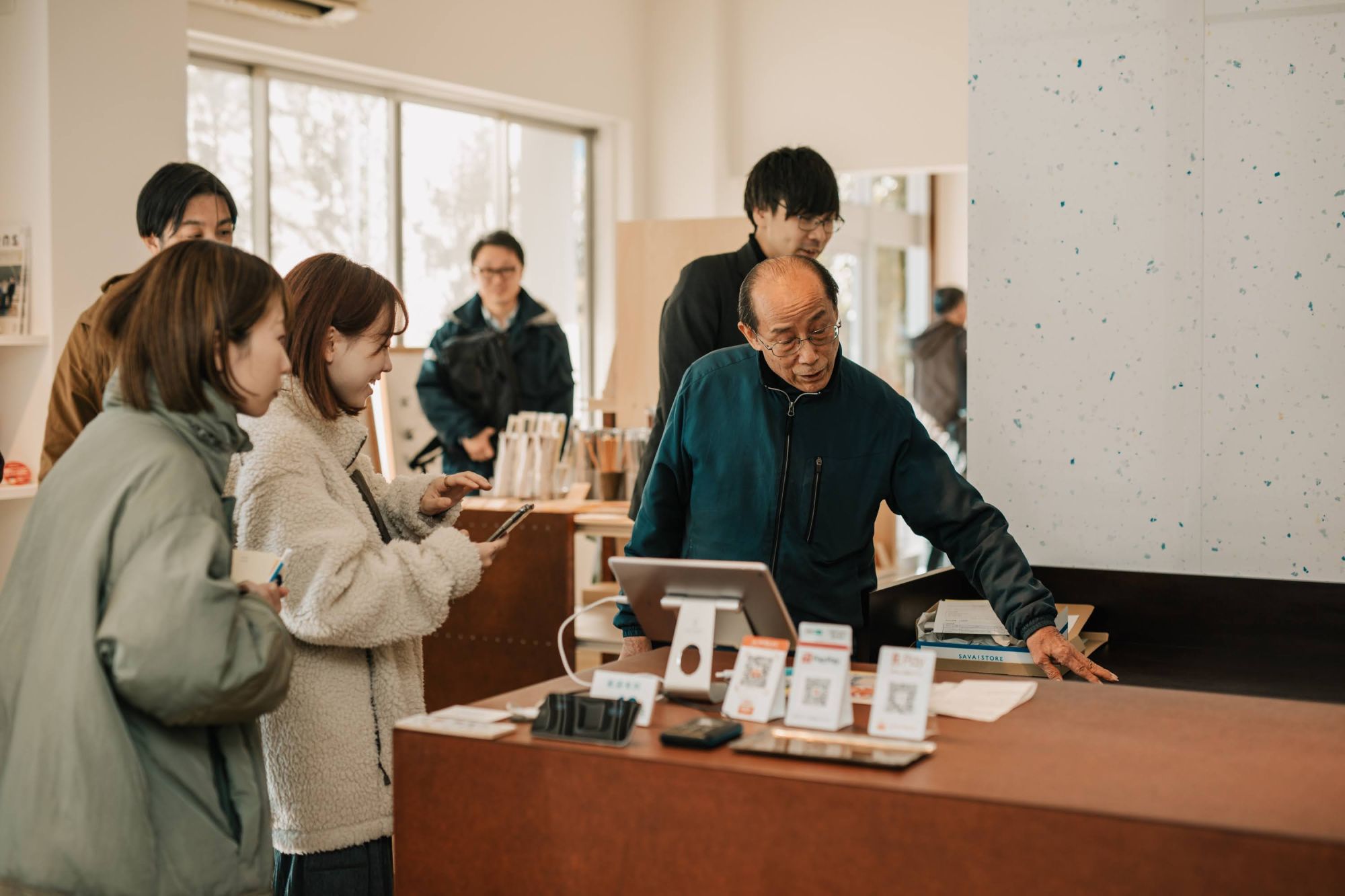
Another place Nagata recommends checking out is the cash register counter of "SAVA!STORE," a shop selling traditional crafts and original miscellaneous goods from Fukui, which is located on the same premises as Nishikikori Lacquerware Store."I made a cash register counter out of MDF, a material used for furniture boards and the like, coated with lacquer.Paint dries quickly, but lacquer takes time to dry, and the lacquer is absorbed differently in different places.I was amazed at the unique texture it achieved after about five or six coats.”
Mr.Kinkori also felt that the combination of MDF and lacquer coating offered new possibilities, saying, “This was a turning point in the more than 90 years since the company's founding".
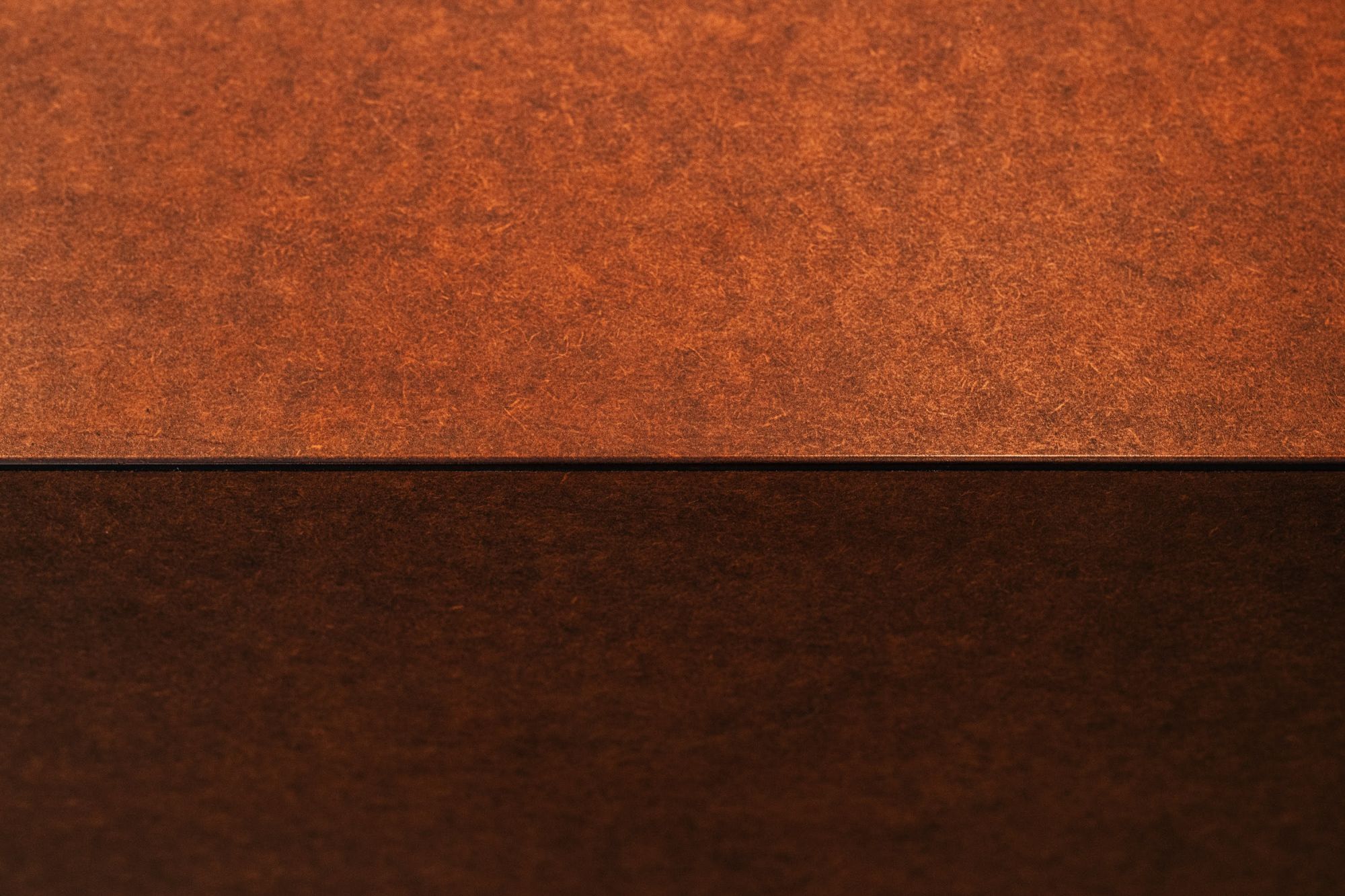
The small mouth (cross section) of the wood, which absorbs the lacquer, is darker in color as if it had been trimmed.In addition to being coated with lacquer to make it durable, you can also enjoy the change in expression as it ages.
"Lacquer can be applied to anything except water and air,” says Mr.Kinkori.He was enthusiastic about pursuing new expressions of lacquer in the future by combining lacquer, which has a long history, with different materials.
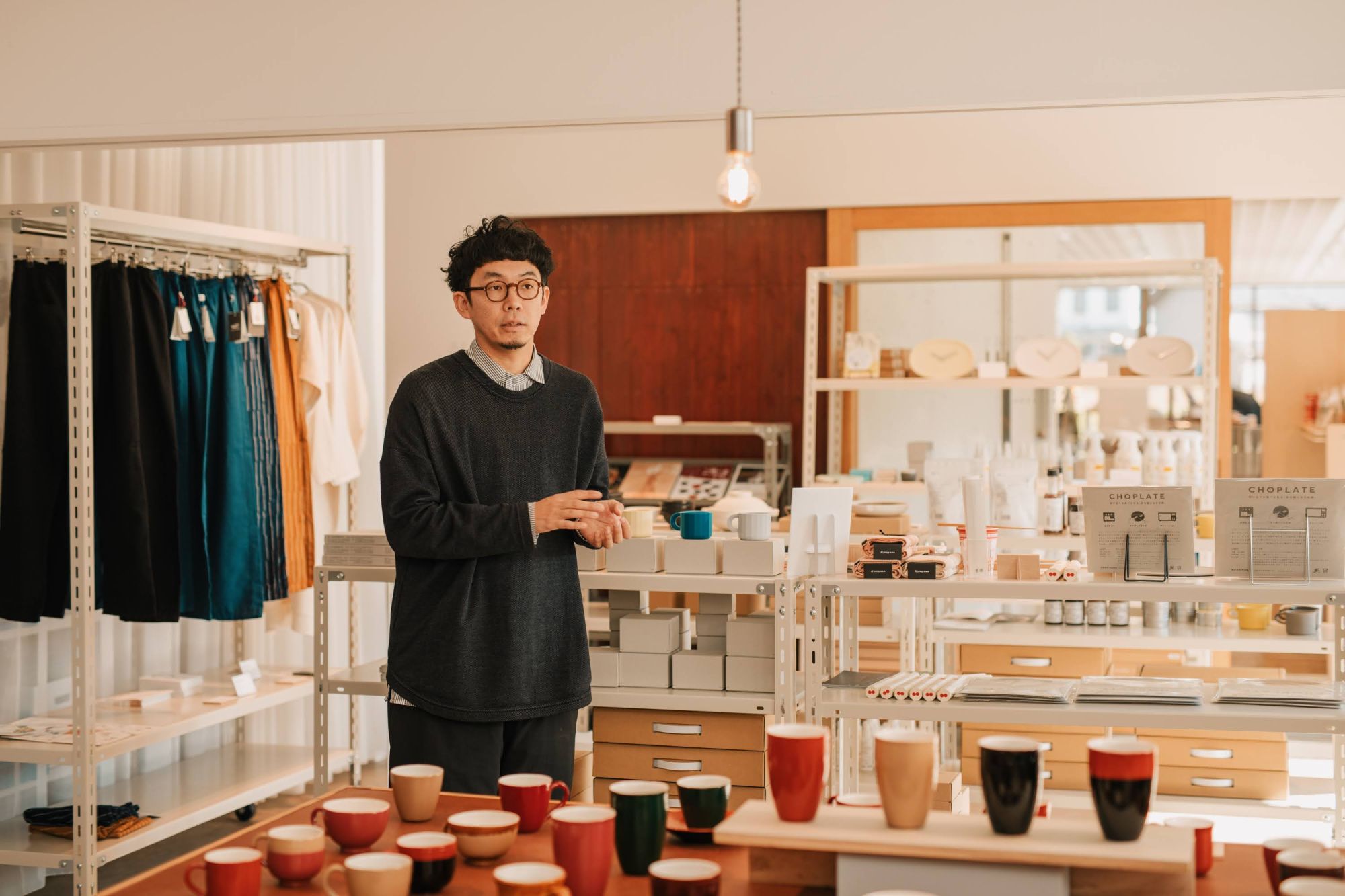
After speaking with Mr. Kinkori, Mr. Naohiro Niiyama of the design firm “TSUGI,” which operates the “SAVA!STORE,” also explained the craftsmanship of Echizen and Sabae.
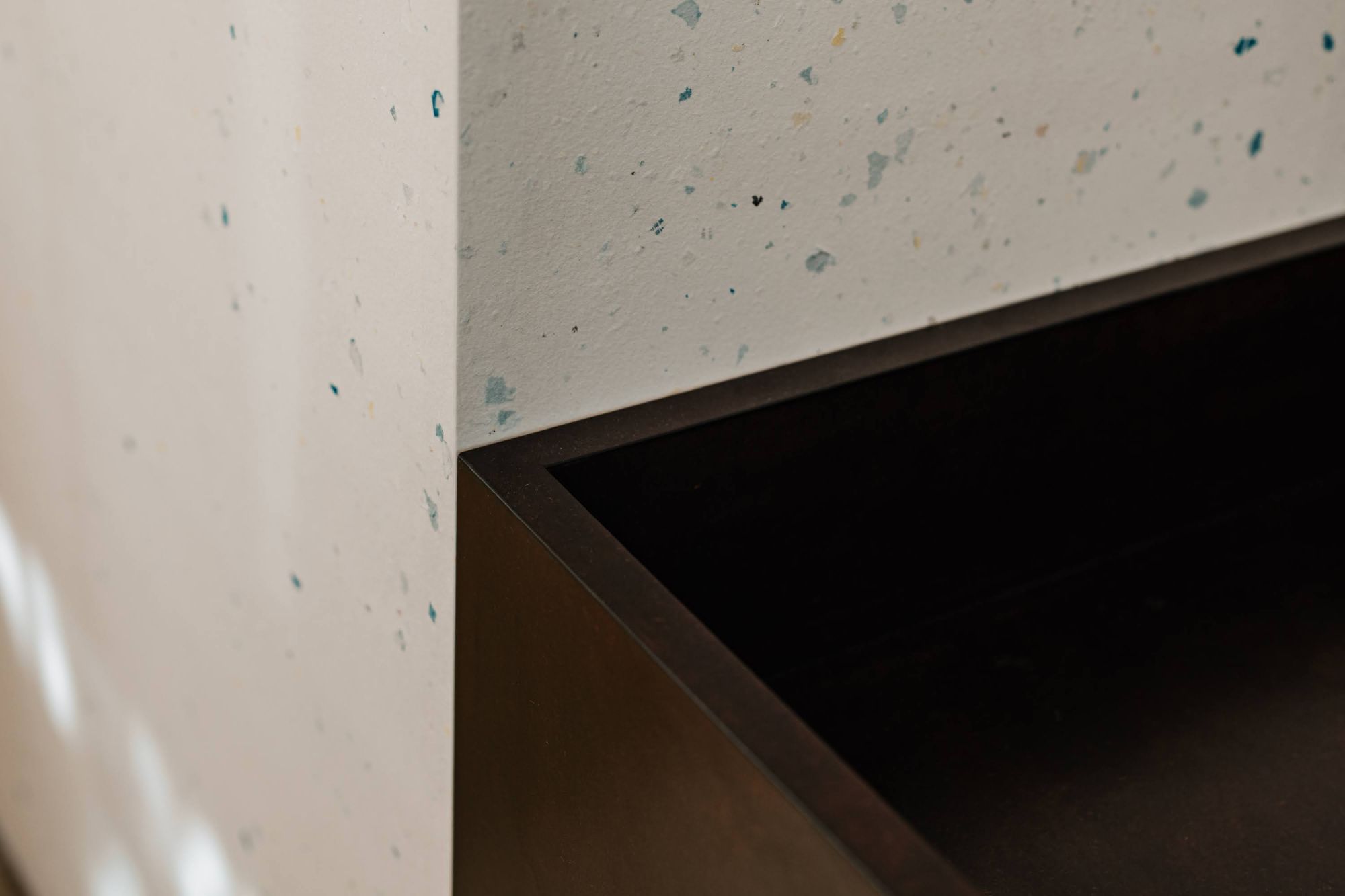
The store, which features good products from Fukui, incorporates Echizen washi paper as well as a lacquered cash register counter by Mr.Kinkori.
For example, the shoji paper in the store is Echizen Washi.Flyers and flyers that would otherwise be thrown away at design offices are mixed with raw materials for paper and made by Echizen washi craftsmen.
Everyone at Nomura Co. also documented the various areas of the store, saying, “It's interesting not only as a place to shop, but also as a place where you can see examples of how various crafts are incorporated into a space."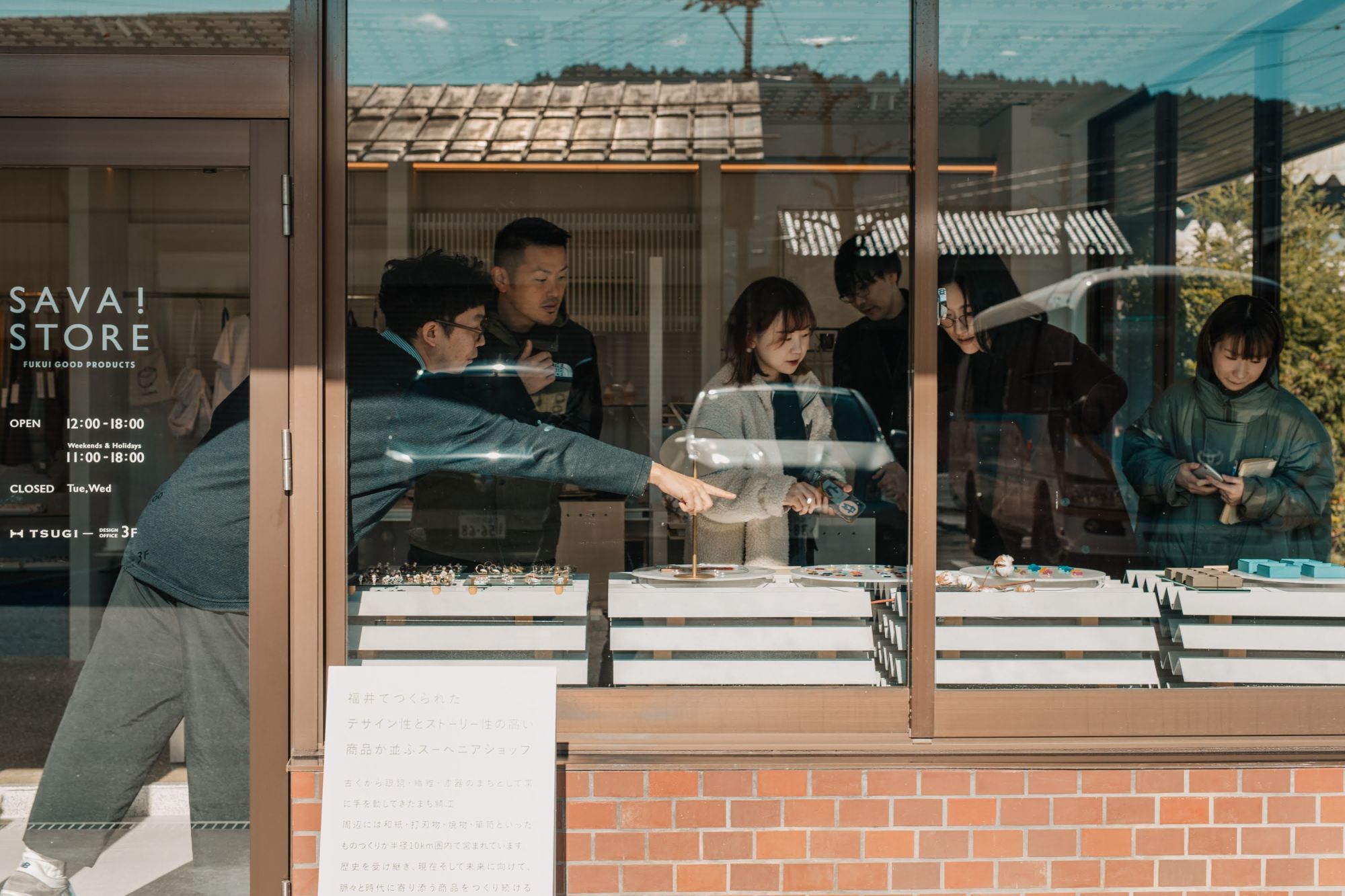
On this trip, we traveled further north from Sabae City to Fukui City.
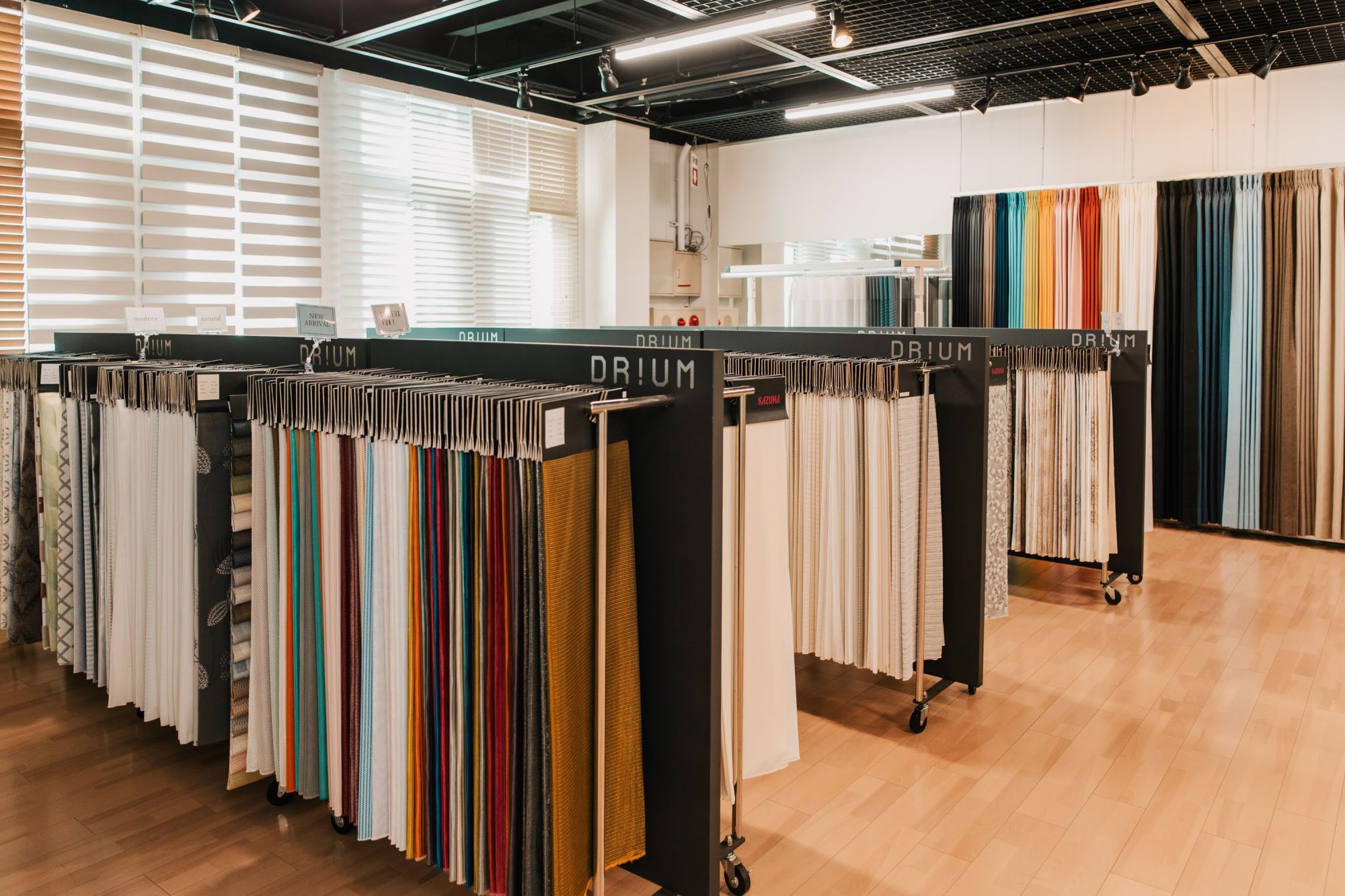
Fukui Prefecture is also a textile production center.Kazuma Corporation, which plans, manufactures, and sells curtains and other home fashion products, has been developing a variety of products using its 60 years of expertise in fabric making, sewing, and embroidery, including knitted lace.
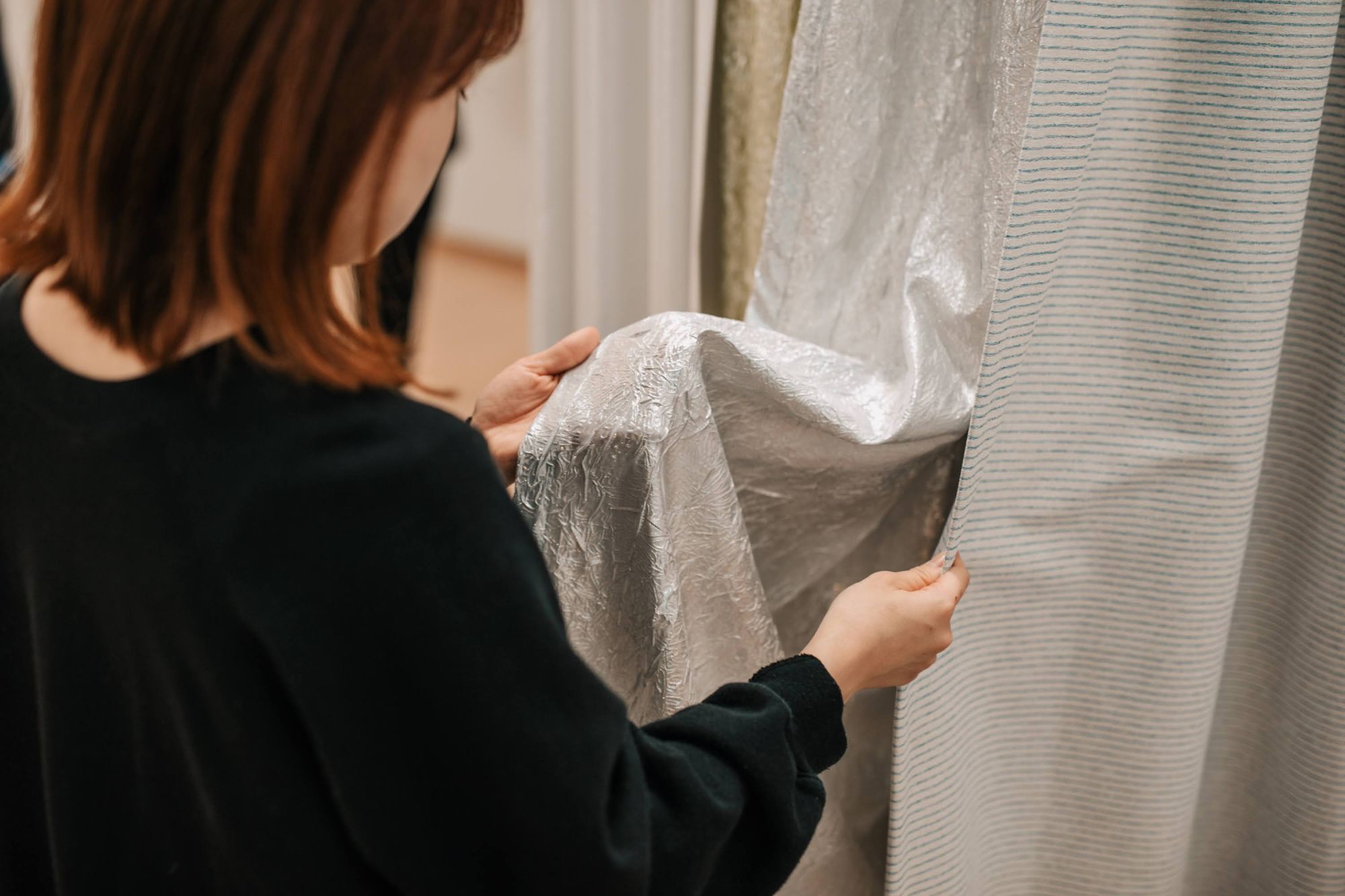
They are also actively engaged in in-house projects led by young employees, such as collaborations with designers, use of recycled and upcycled materials, and manufacturing using natural materials.
They have developed products with functions that go beyond conventional curtains, such as decorating a space, “making it invisible from the outside,” and “dividing a space,” and they are used both indoors and outdoors.
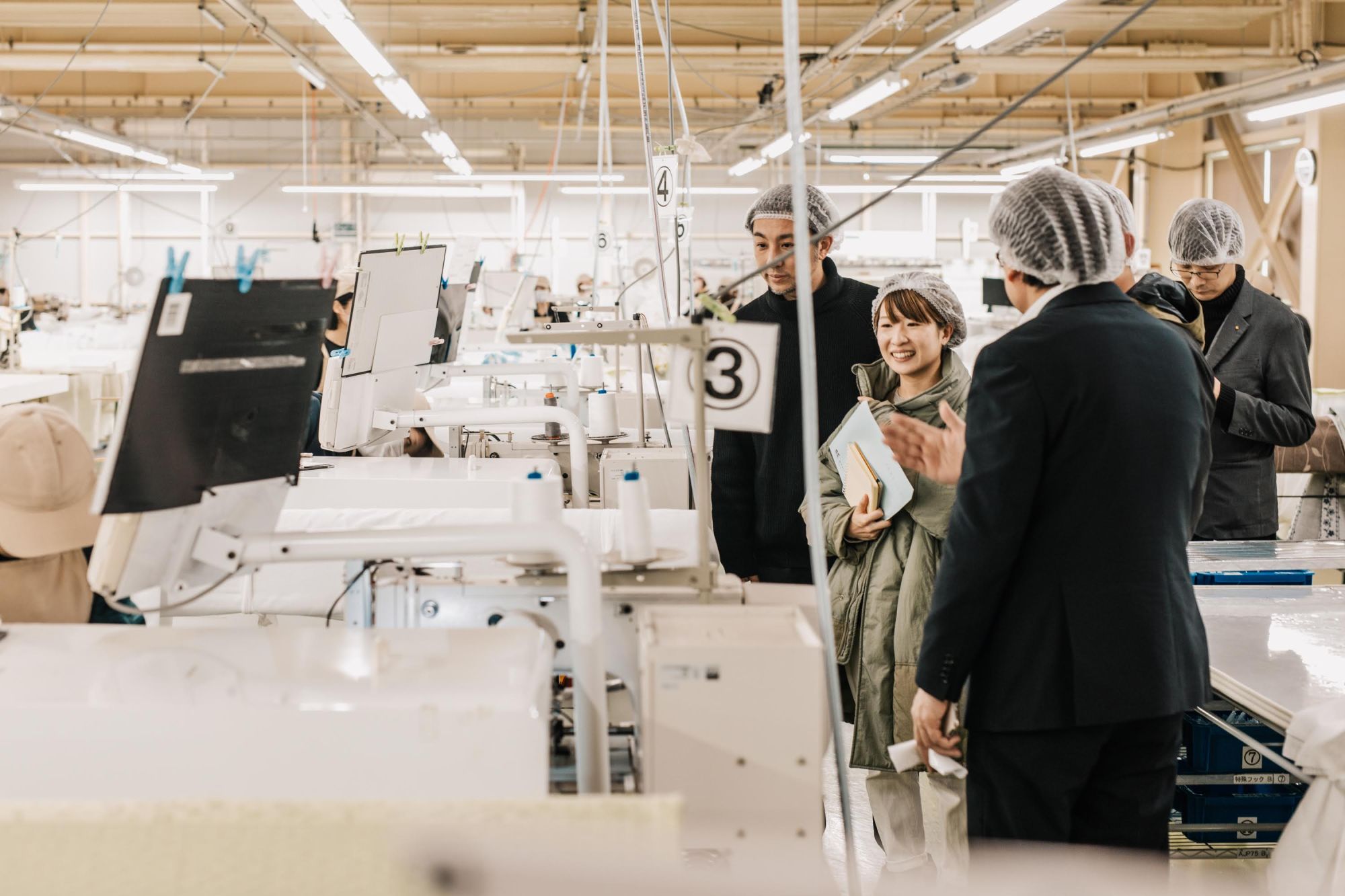
The tour included a factory with a wide range of models and a gallery of multifunctional curtains with a rich variety.Fabrics made from scraps and embroidery techniques may provide inspiration for creating new spaces.
Marvel Corporation of Fukui City introduced Marvel Wood, a proprietary wood preservative that provides three functions: “durability", "environmental friendliness", and "aesthetic appeal".
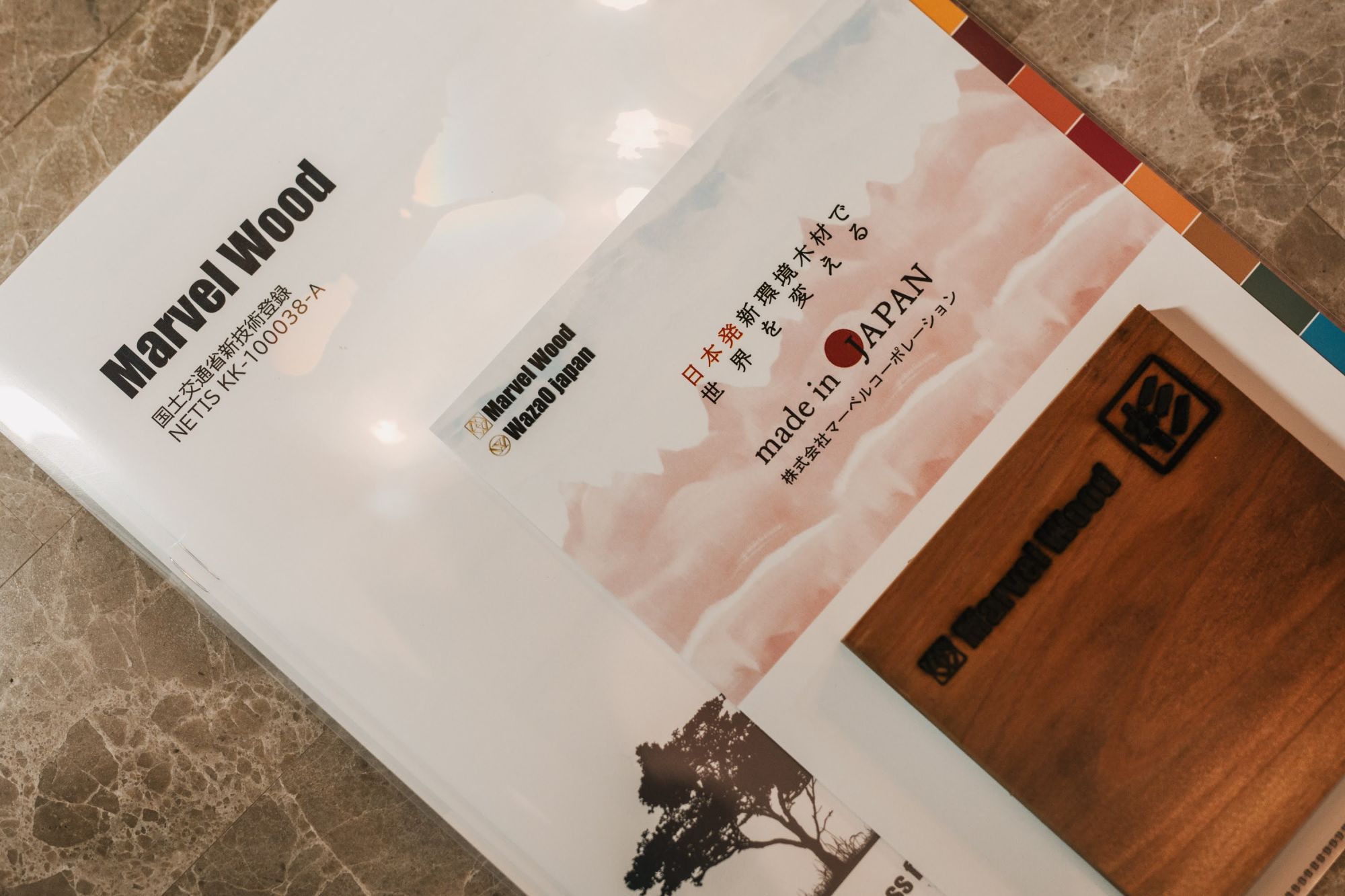
Marvel Wood, which was developed and improved over a period of more than 10 years, is made of Japanese cedar, cypress, and other timbers injected with wood preservatives and termiticides to overcome the low durability that has been a drawback of wood.In addition to its high durability as an exterior component, it does not detract from the texture of the wood.
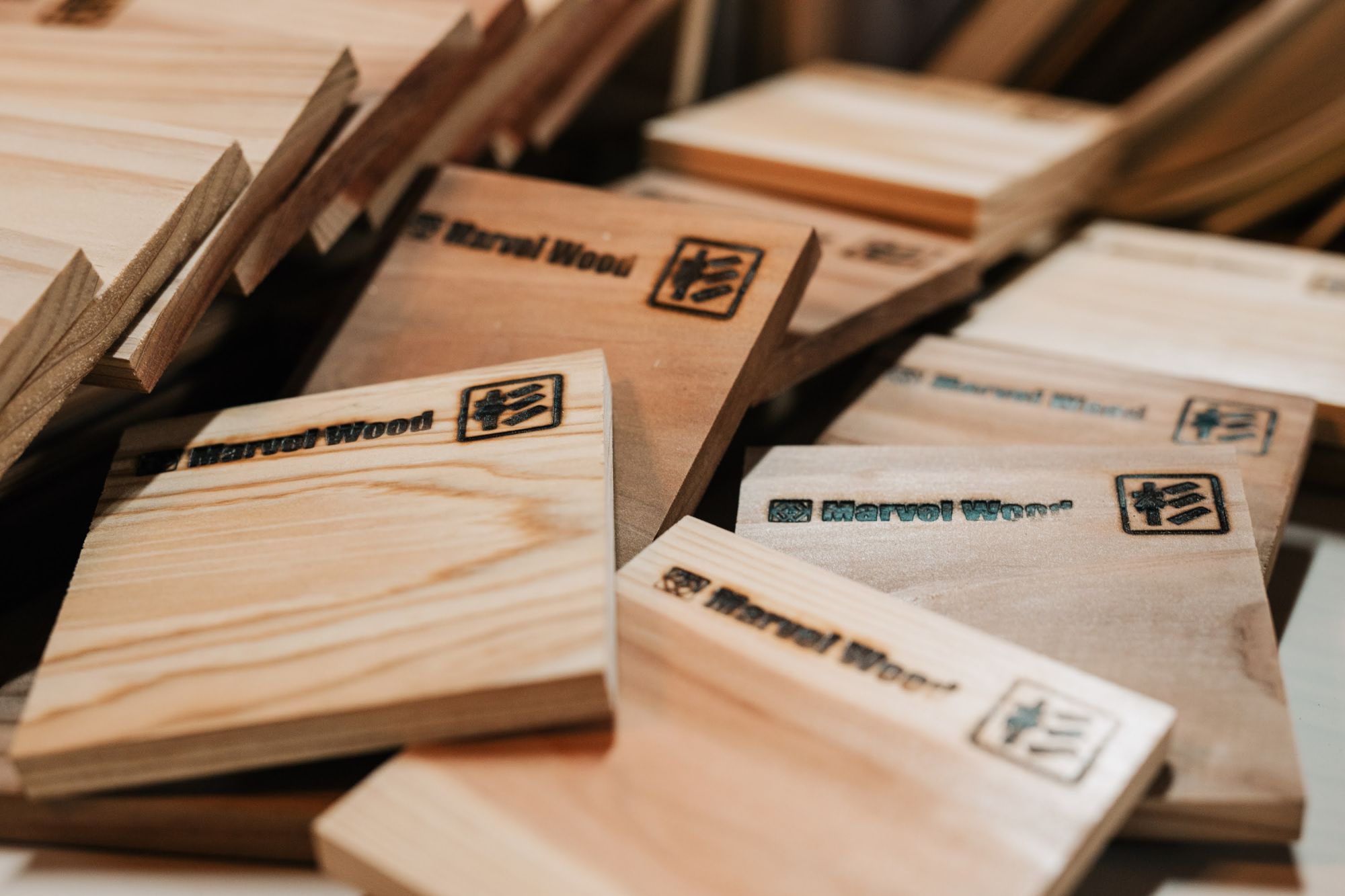
In addition to public works projects such as parks, Marvel Wood has been used in Japan and overseas for the deck of "Kitano Tenmangu Shrine in Kyoto", the “Pond garden and gardens in the Kyoto Imperial Palace", and the exterior walls of a university in Taiwan.
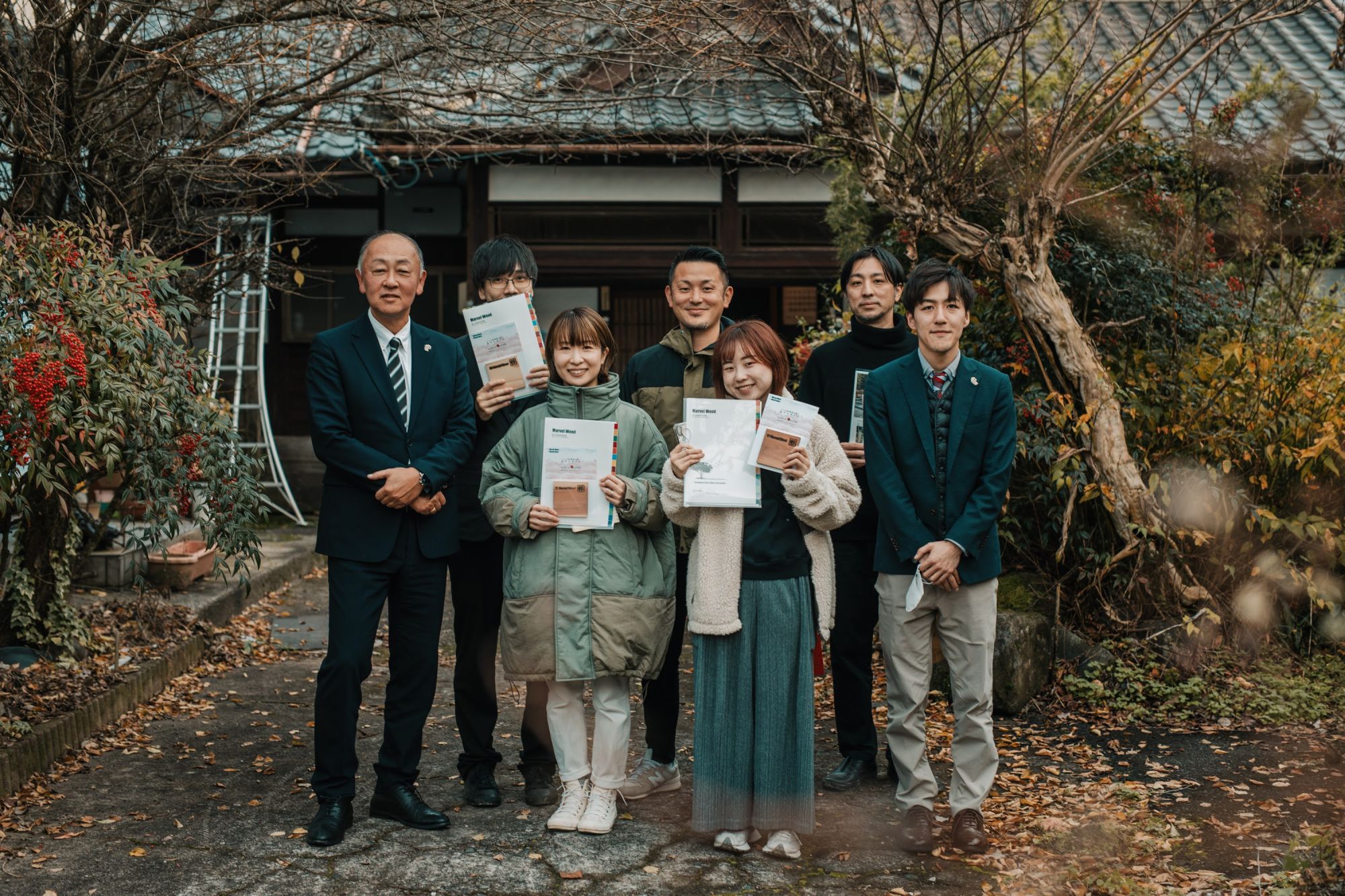
"The process is very attractive because it prevents deterioration, which is very important in the context of the growing demand for the use of local lumber."says Mr.Nagata.The Nomura Co. staff members seemed to have no end of conversations with Seisuke Ozawa (photo at left), representative of the company, saying, “We want to use this product right away,” and “We can confidently propose the use of wood for outdoor use as well".
Tour of Echizen and Fukui production areas
Mr. Nagata and The Nomura Co. staff who spent two days touring Echizen Washi paper sites.Here are some of their thoughts on this trip.
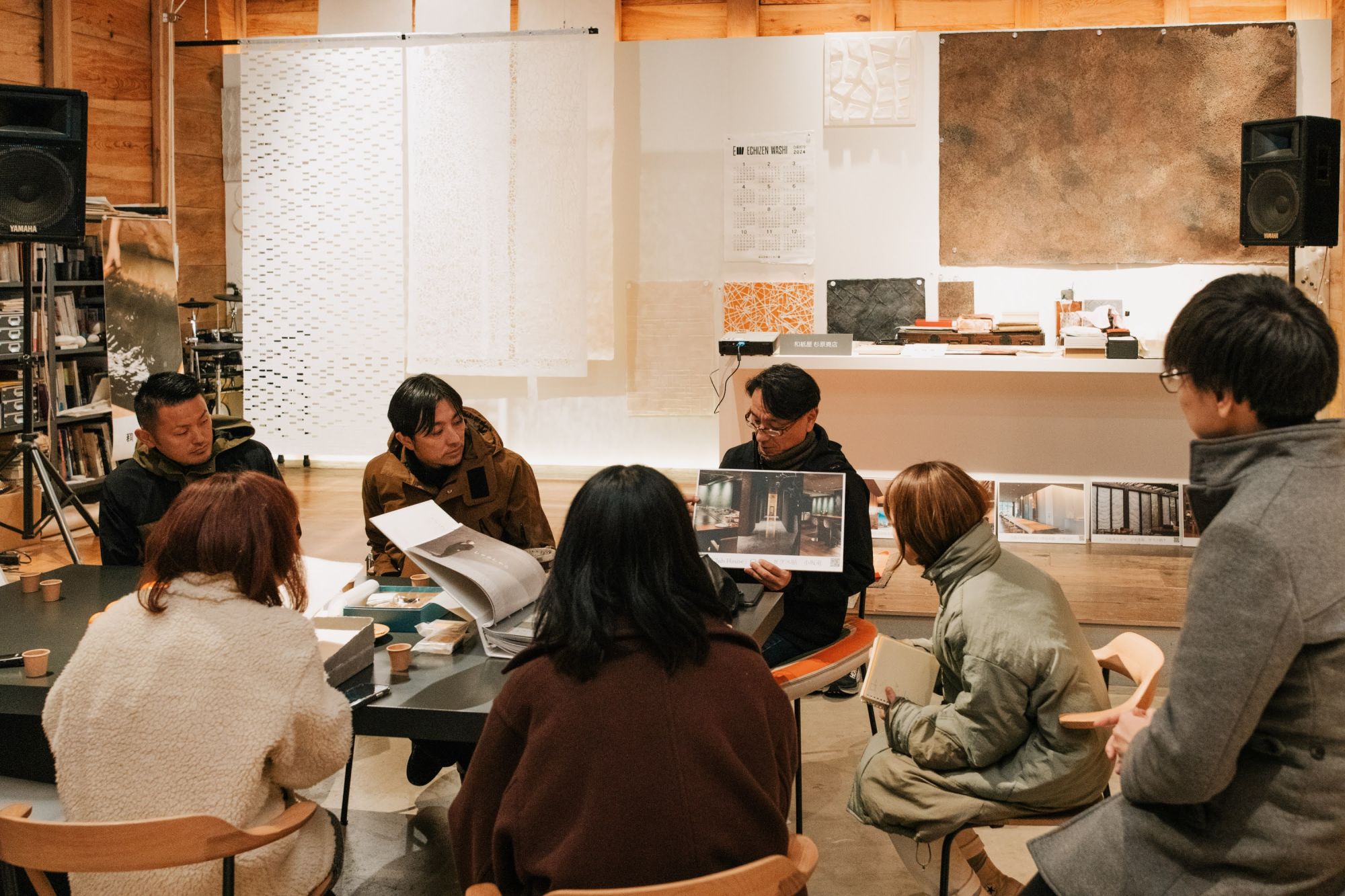
“I have been on individual site visits in the past, but by visiting as a group, we were able to deepen our discussions and I sensed a great deal of business opportunity. Next time I would like to visit a place where I can actually experience these materials in real life.”
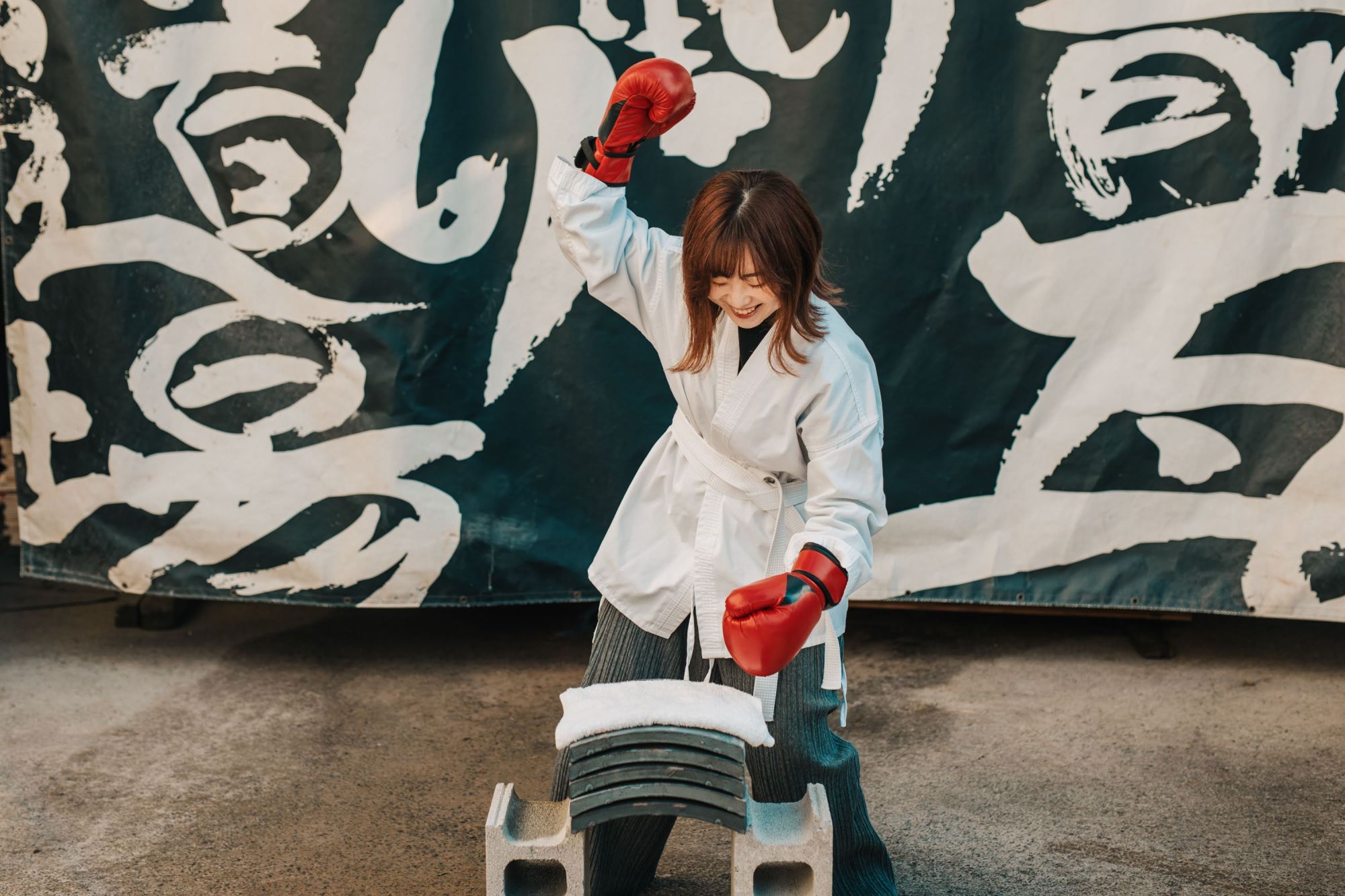
“In addition to the tour, the experience of making paper and splitting roof tiles was memorable and provided an opportunity to experience the high level of skill and quality of the products.The process of production provided a lot of inspiration for those of us who design spaces.”

“Knowing the process of manufacturing has made it easier for us to consider new methods of expression and to make presentations to our clients, Just an idea, but I think that by creating a platform that broadly picks up each industry in Fukui, there will be more touch points for people outside the prefecture and overseas to learn about Fukui's craftsmanship.”

Mr.Nagata says, “Visiting a workshop, talking with the craftspeople, and learning about the craftsmanship is something you can only experience by coming to the production center."Through the encounters with Echizen and Fukui craftsmanship during the two-day tour, visitors seemed to be able to feel the possibilities of new materials that had never existed before.
On the ride home, it was impressive to see everyone reflecting on the trip and talking about their impressions and how they would use the program in the future.